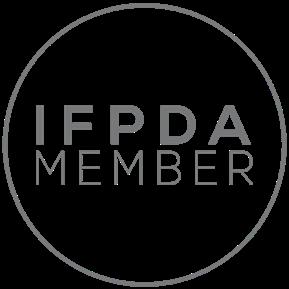shapero MODERN shaperomodern.com
shapero MODERN 41-43 Maddox Street London W1S 2PD +44 (0)20 3693 2197 modern@shapero.com shaperomodern.com
Suite of five relief prints, 2019, on Hahnemühle Aurora paper, signed in pencil, numbered from the edition of 35 (there were also 8 artist’s proofs), published by PACE NY, 100 x 75 cm. (39¼ x 29½ in.)
[ref: 101231]
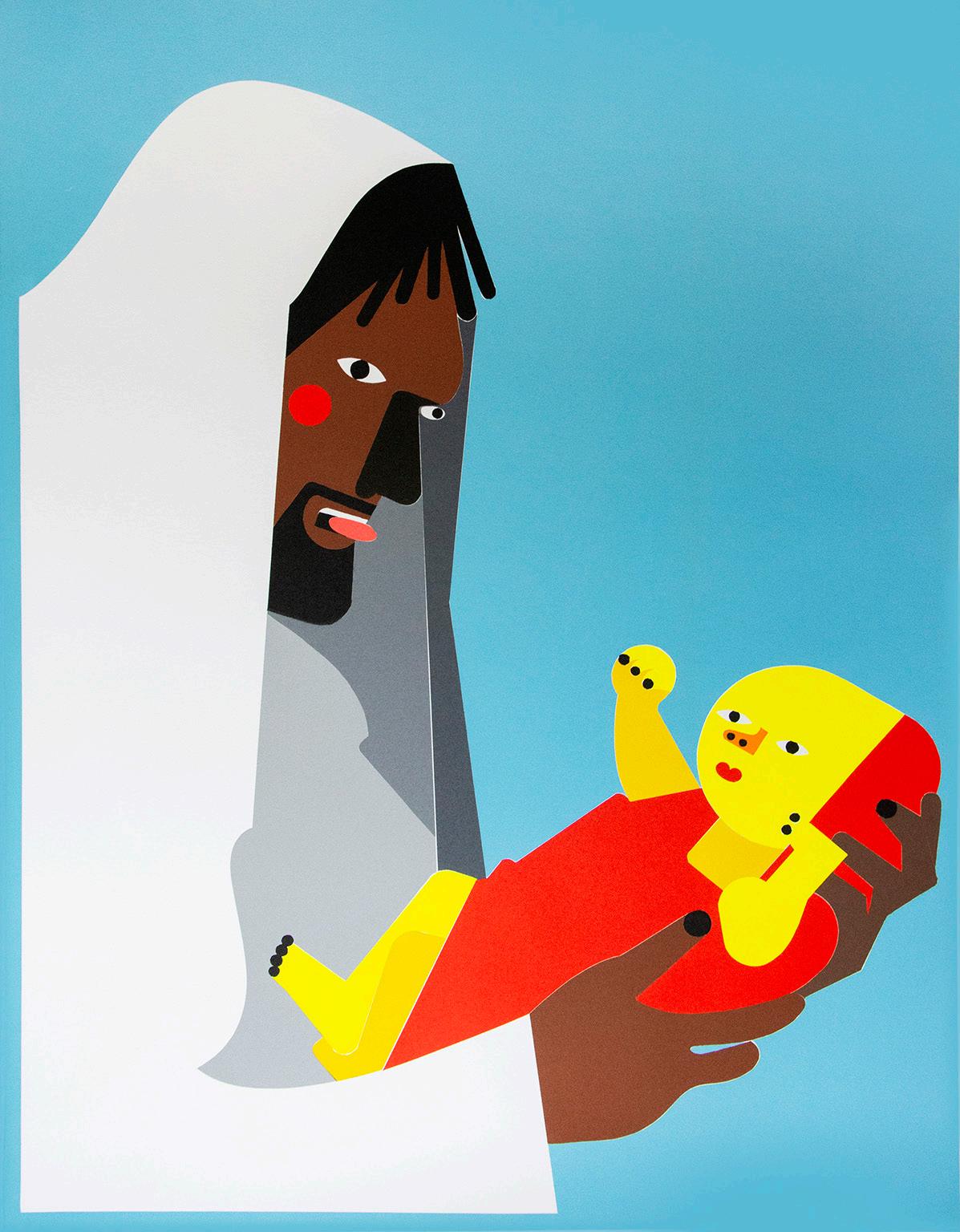 1. ABNEY, Nina Chanel. Temporary Friends
1. ABNEY, Nina Chanel. Temporary Friends
Nina Chanel Abney was born in Chicago and currently lives and works in New York. Abney is known for her bold use of colours to represent a more violent every day consciousness that people of colour endure due to acts of racial abuse. Her work is included in collections around the world, including the Brooklyn Museum, the Rubell Family Collection, the Bronx Museum of the Arts, and the Burger Collection, Hong Kong.
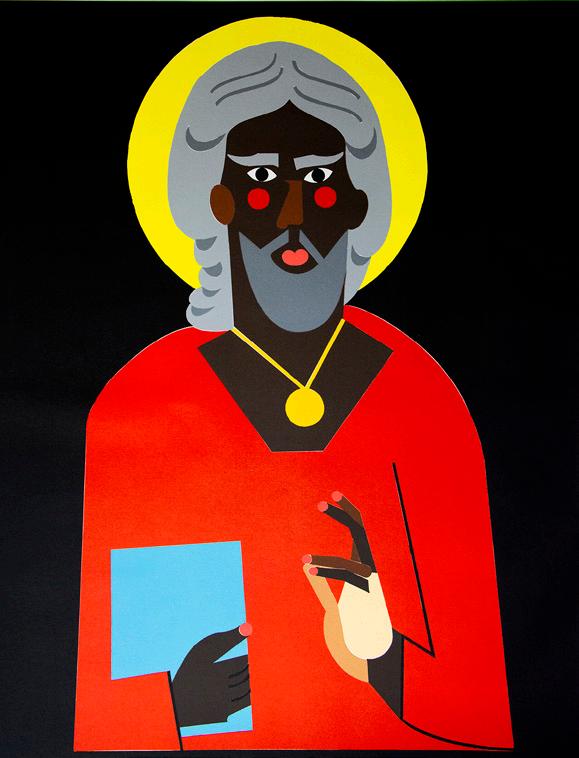
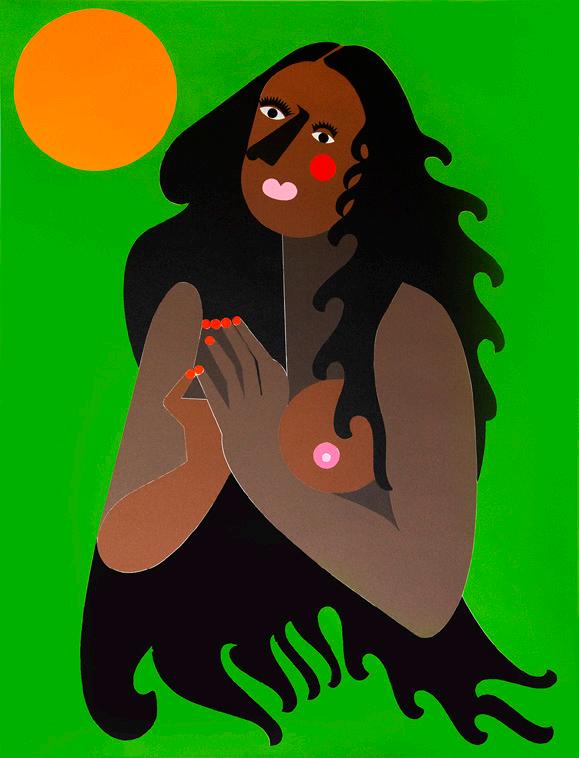
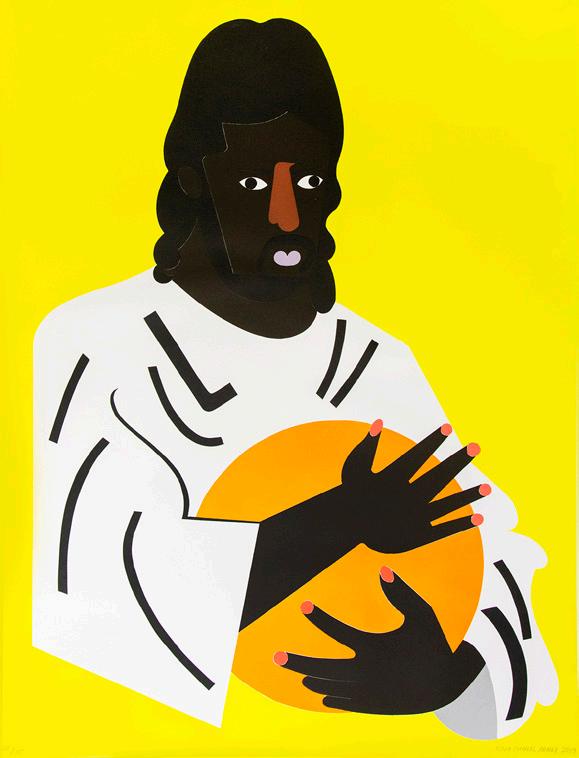

Lithograph in colours, circa 1965, on Rives paper, signed in pencil, from the edition of 75, published by Mourlot, Paris, 55.9 x 75.6 cm. (22 x 29¾ in.)
[ref: 109097]
 2. CALDER, Alexander. L’Acier du Constructeur 1965
2. CALDER, Alexander. L’Acier du Constructeur 1965
Lithograph in colours, 1969, on Rives BFK paper, signed in pencil, from the edition of 75, published by Maeght, Paris, 74.9 x 54.6 cm. (29½ x 21½ in.)
[ref: 109098]
 3. CALDER, Alexander. Encore de l’Acier 1969
3. CALDER, Alexander. Encore de l’Acier 1969
4. ESTES, Richard. Urban Landscapes No. 3
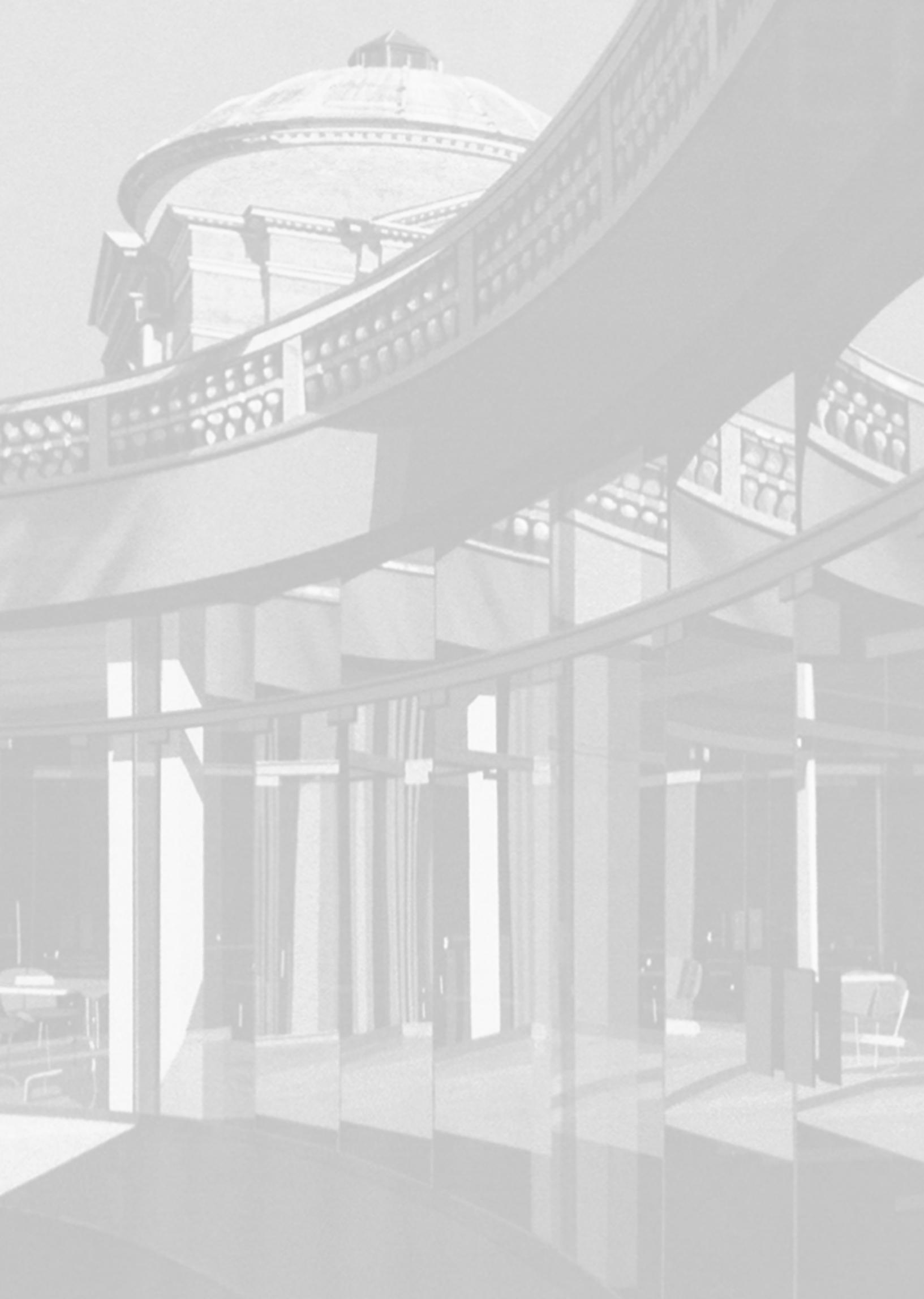
A prominent figure in the Photorealist movement, Estes captures the essence of New York’s urban landscapes through meticulously composed paintings, utilizing multiple source photographs to recreate reality with remarkable precision.
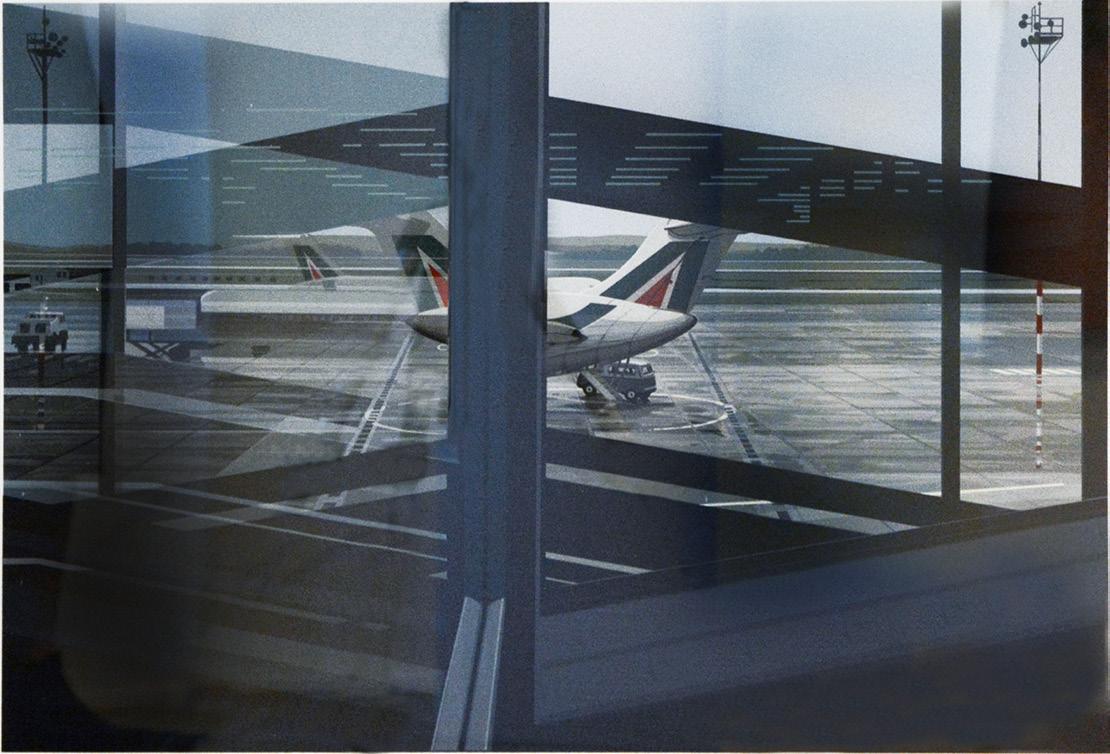

His incorporation of reflective surfaces creates mirrored imagery, elevating our perception beyond what the naked eye can grasp.


4 screenprints (of 8) in colours, 1981, on Fabriano Cottone paper, with full margins, each signed in pencil and numbered from the edition of 250 (there were also 15 artist’s proofs), published by Parasol Press, Ltd., New York, each sheet 50 x 70 cm. (19¾ x 27½ in.)
[ref: 102220]

5. ESTES, Richard. Urban Landscapes No. 3

A prominent figure in the Photorealist movement, Estes captures the essence of New York’s urban landscapes through meticulously composed paintings, utilizing multiple source photographs to recreate reality with remarkable precision.

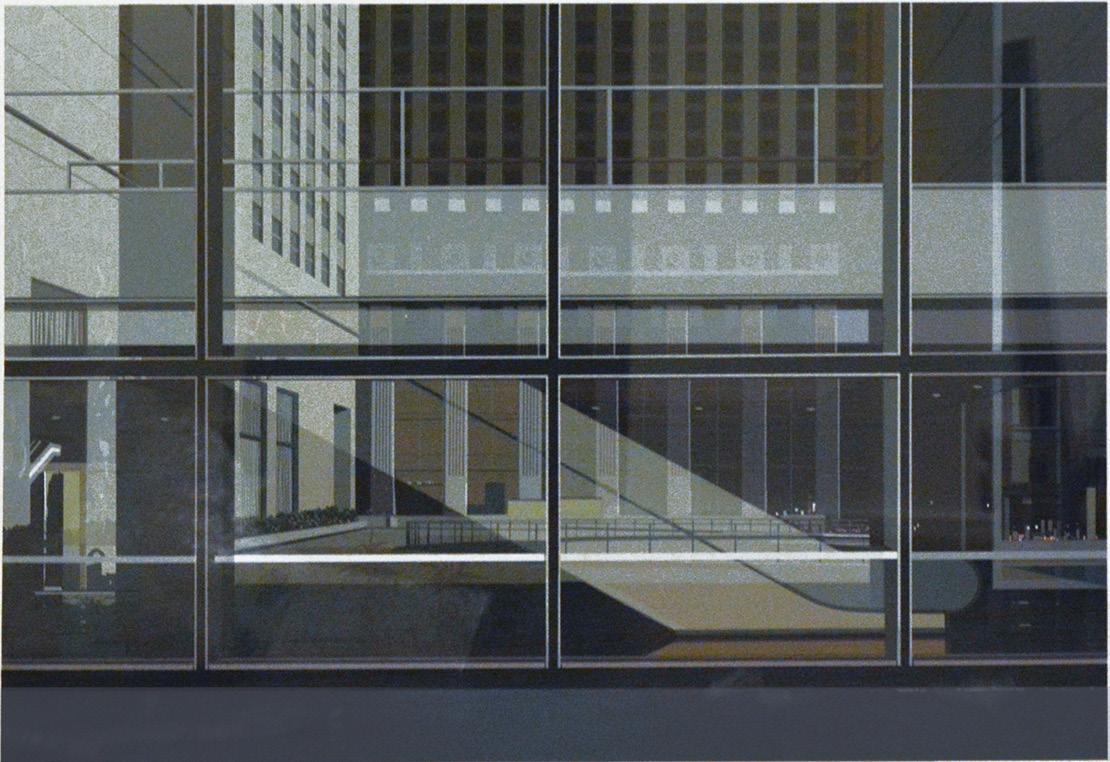
His incorporation of reflective surfaces creates mirrored imagery, elevating our perception beyond what the naked eye can grasp.
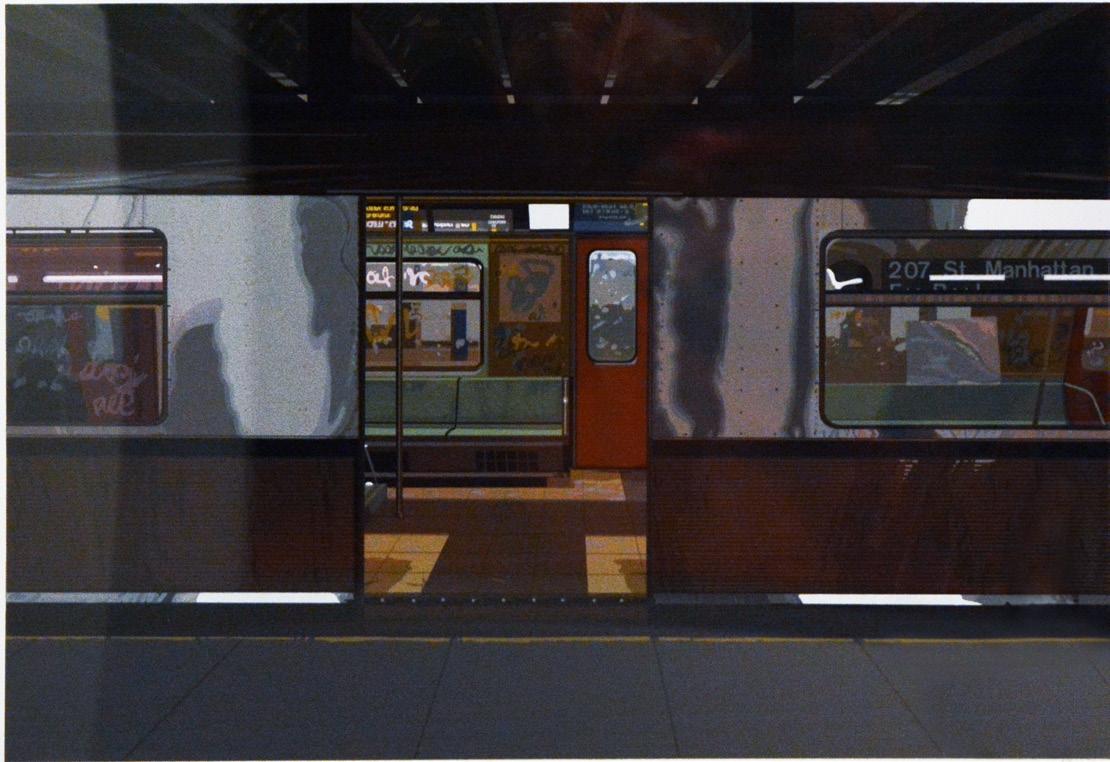

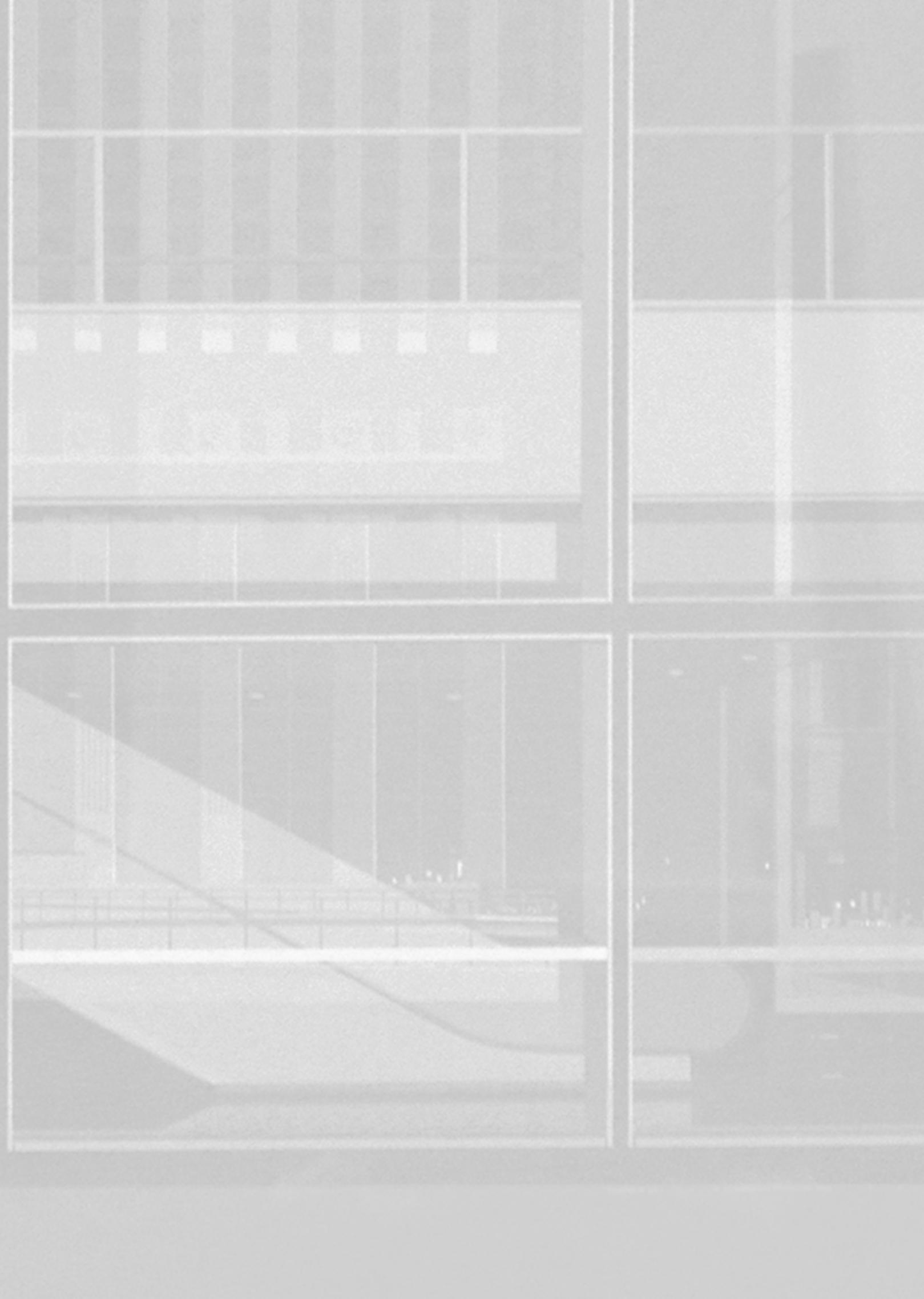
4 screenprints (of 8) in colours, 1981, on Fabriano Cottone paper, with full margins, each signed in pencil and numbered from the edition of 250 (there were also 15 artist’s proofs), published by Parasol Press, Ltd., New York, each sheet 50 x 70 cm. (19¾ x 27½ in.)
[ref: 102220]
6. FRANCIS, Sam. Seal Sail (SF-92)
Lithograph in colours, 1969, on BFK Rives paper, signed and inscribed ‘AP’ in pencil, an artist’s proof aside from the standard edition of 20, printed and published by Tamarind
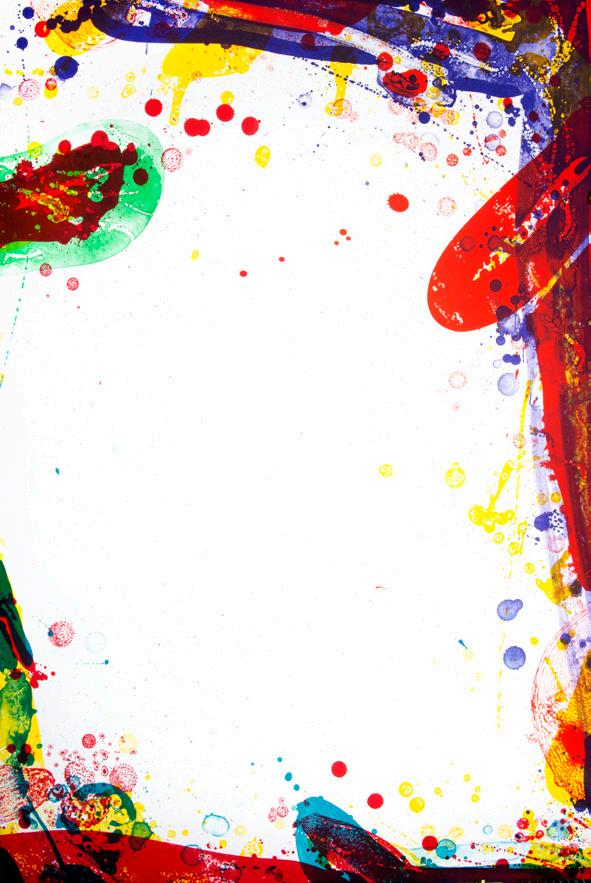
Lithography Workshop, Los Angeles, 91.8 x 63.8 cm (36¼ x 25 in.)
Lembark L. 106 (SF-92)
[ref: 106437]
7. FRANCIS, Sam. Untitled (SF-272)
Offset lithograph in colours, 1984, on BFK Rives paper, signed in pencil, numbered from the edition of 250, printed by the Litho Shop, Inc., Santa Monica, California, published by Museum of Contemporary Art, Los Angeles, 106.7 x 73 cm. (42 x 28¾ in.)
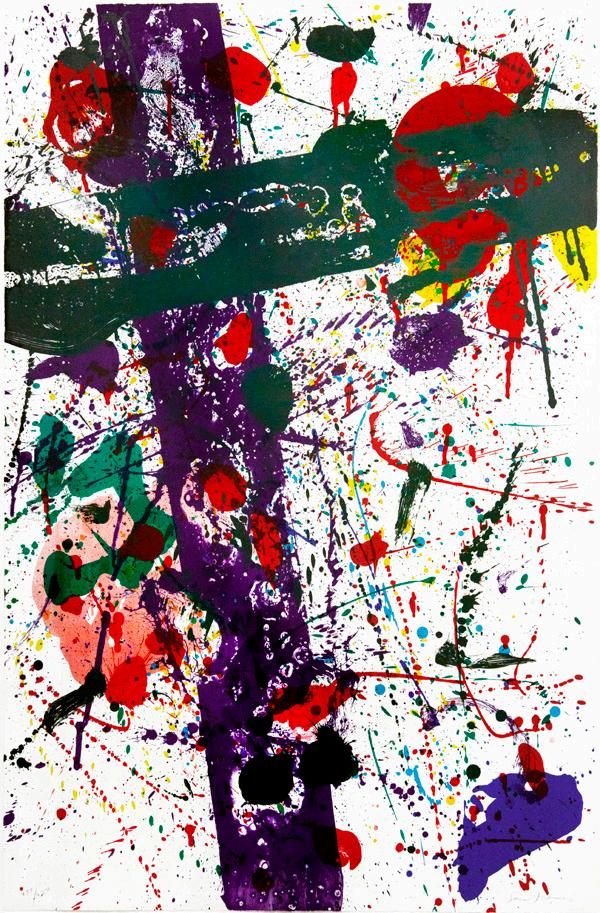
Lembark L. 263
[ref: 107473]
Aquatint in colours, 1991, on wove paper, signed in pencil, numbered from the edition of 27, 61.6 x 44.5 cm. (24¼ x 17½ in.)
[ref: 106436]
Aquatint in colours, 1992, on wove paper, signed and inscribed ‘trial proof’ in pencil, a trial proof aside from the standard edition of 28, printed and published by The Litho Shop, Inc., Santa Monica, 72 x 47 cm. (28¼ x 18½ in.)

[ref: 106434]
 8. FRANCIS, Sam. Untitled (SFE-081)
9. FRANCIS, Sam. Untitled (SFE-085)
8. FRANCIS, Sam. Untitled (SFE-081)
9. FRANCIS, Sam. Untitled (SFE-085)
Exemplary of Frankenthaler’s individual approach to painting with the use of thinned paint applied to pastel coloured paper from all sides to create floating fields of colour with interjections of bright pigments and open surface space.
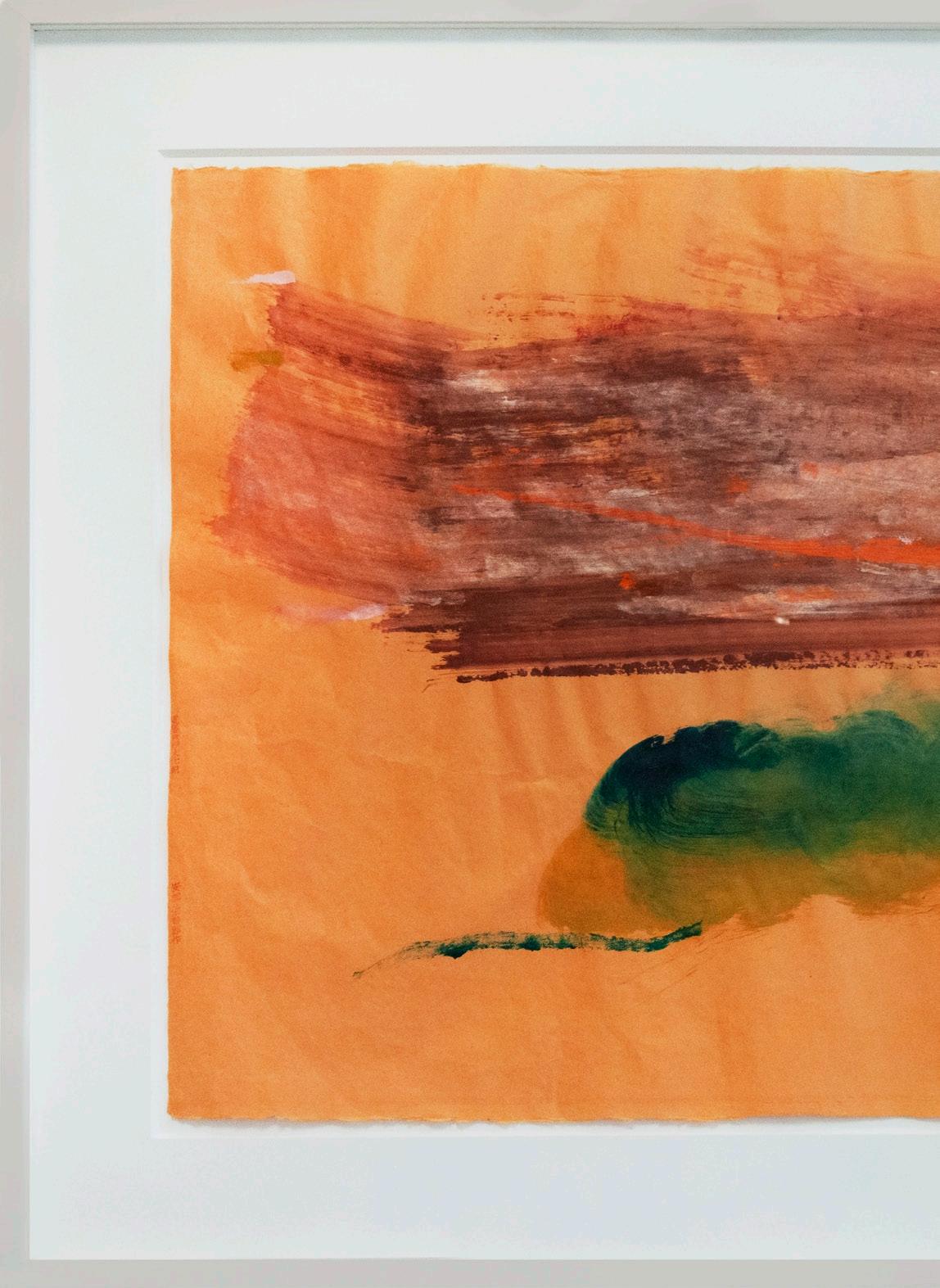 10. FRANKENTHALER, Helen. Orient Express #6
10. FRANKENTHALER, Helen. Orient Express #6
Provenance: Estate of the Artist; Gagosian Gallery, London; Christie’s London, Sale 20664, Private Collection.
A unique work, 1977, acrylic on paper, signed and dated ‘Frankenthaler ‘77’ in pencil, 61 x 99 cm. (24 x 39 in.)
[ref: 107026]

Lithograph in colours, 1987, on TGL handmade paper, signed and dated in pencil, inscribed ‘P.P.’ a printer’s proof aside from the standard edition of 47, published by Tyler Graphics Ltd., Mt. Kisco, New York, with their blindstamp, 60 x 46 cm. (23½ x 18 in.) Harrison 132
[ref: 108066]
 11. FRANKENTHALER, Helen. Tribal Sign 1987
11. FRANKENTHALER, Helen. Tribal Sign 1987
Lithograph, drypoint, etching in colours, 1987/88, on handmade wove paper, signed in pencil, numbered from the edition of 75, 87 x 68 cm. (34¼ x 26¾ in.)
[ref: 107451]
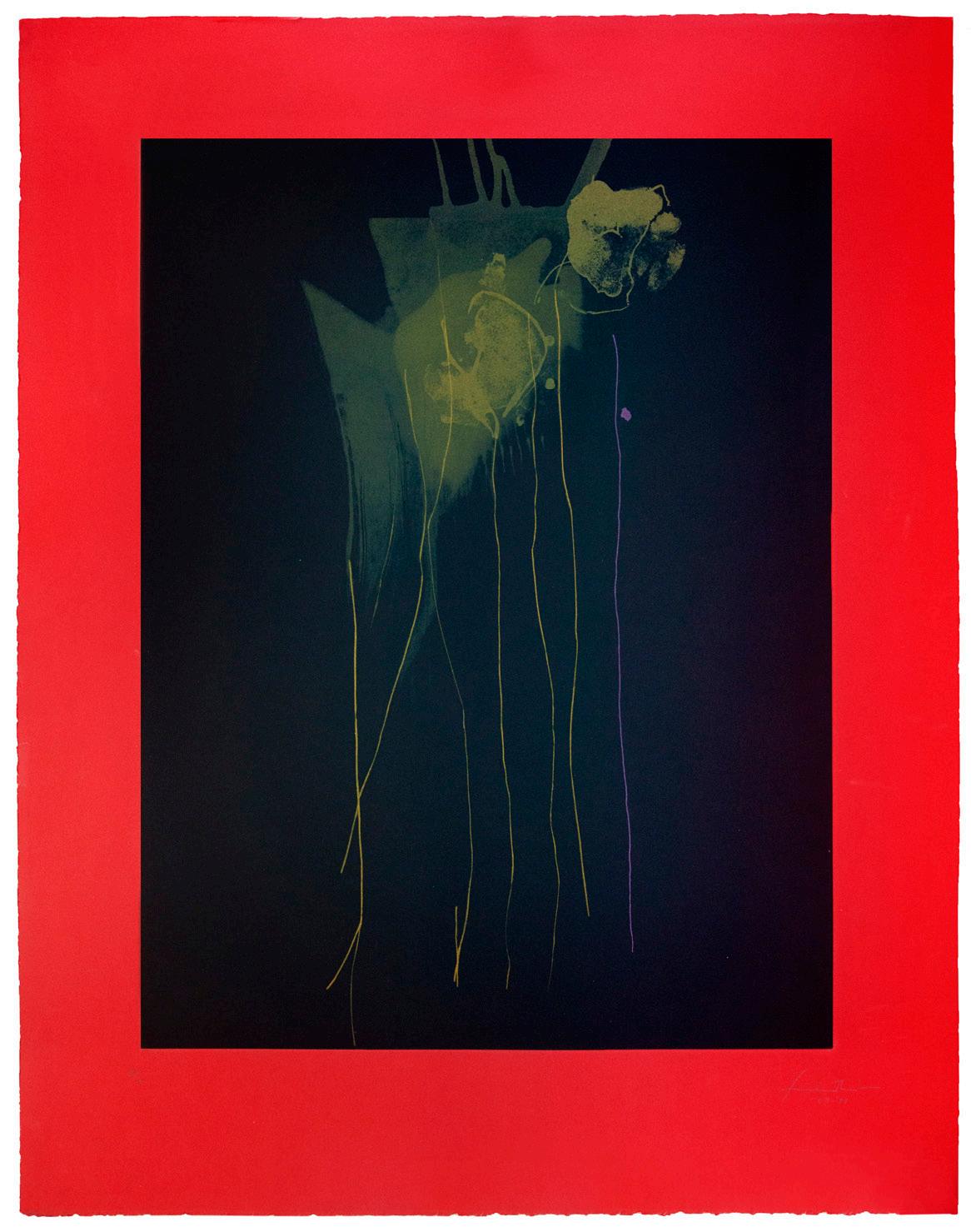 12. FRANKENTHALER, Helen. Ramblas 1987
12. FRANKENTHALER, Helen. Ramblas 1987
Screenprint and offset lithograph in colours, 1990, on wove paper, signed in pencil, numbered from the edition of 72 (there were also 9 Artist’s Proofs), published by Lincoln Centre, New York, 106.7 x 81.3 cm. (42 x 32 in.)
[ref: 108987]
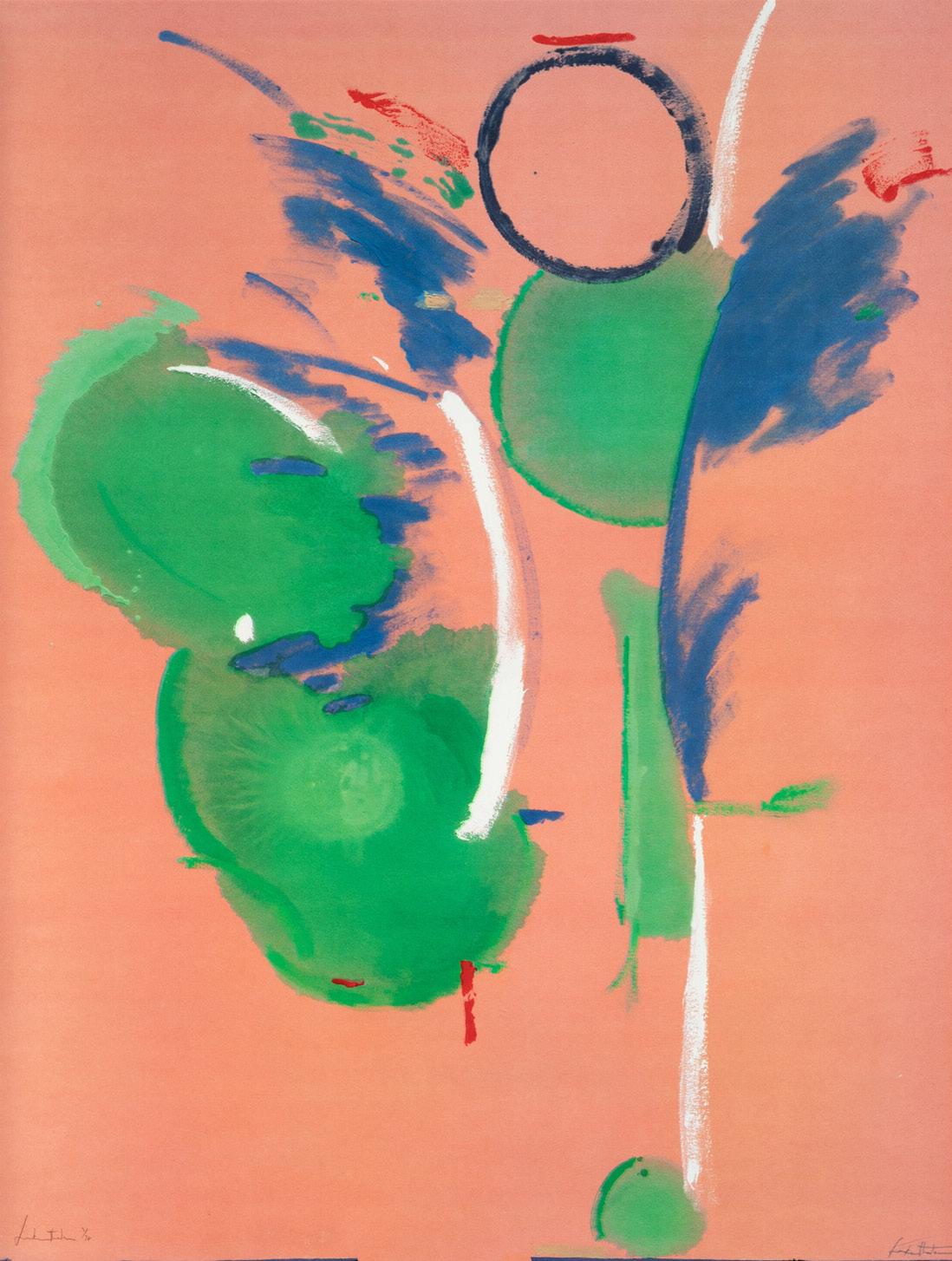 13. FRANKENTHALER, Helen (after). Mary, Mary 1990
13. FRANKENTHALER, Helen (after). Mary, Mary 1990
14. FRANKENTHALER, Helen. Reflections II 1995

Lithograph in colours, 1995, on BFK Rives paper, signed and dated in pencil, inscribed ‘P.P.’ a printer’s proof, aside from the standard edition of 30, published by Tyler Graphics Ltd., Bedford, with their blindstamp, 67.9 x 53.3 cm. (26¾ x 21 in.)
[ref: 107014]
Screenprint in colors, 2006, on Rives BFK paper, signed and dated in pencil, numbered from the edition of 120, published by the Naples Art Museum, Florida, 78.7 x 93.7 cm. (31 x 37 in.)
[ref: 108703]
 15. FRANKENTHALER, Helen. Flotilla 2006
15. FRANKENTHALER, Helen. Flotilla 2006
Lithograph, 1980, on Barcham Green Crisbrook paper, with the artist’s estate stamp as issued, numbered from the edition of 50 (there were also eleven artist’s proofs), published by Gemini G.E.L., Los Angeles, 1981, with their blindstamps and ink stamp on the reverse, 50.2 x 75.6 cm. (19¾ x 29¾ in.)Semff 38; Gemini 1065
[ref: 108705]
 16. GUSTON, Philip. Pile Up
16. GUSTON, Philip. Pile Up
17. HARING, Keith. Apocalypse Suite
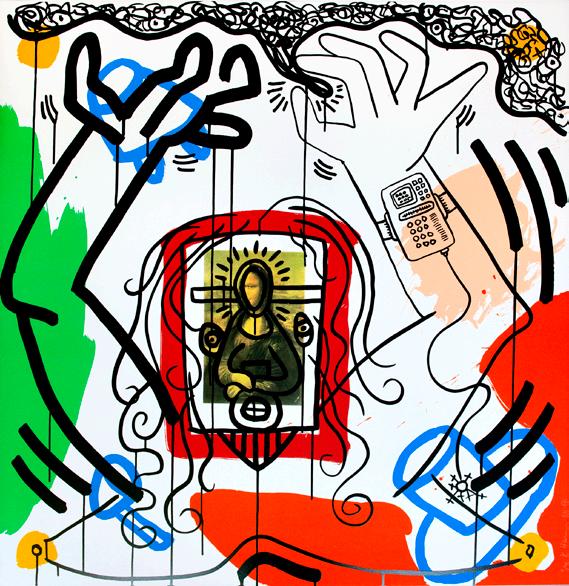
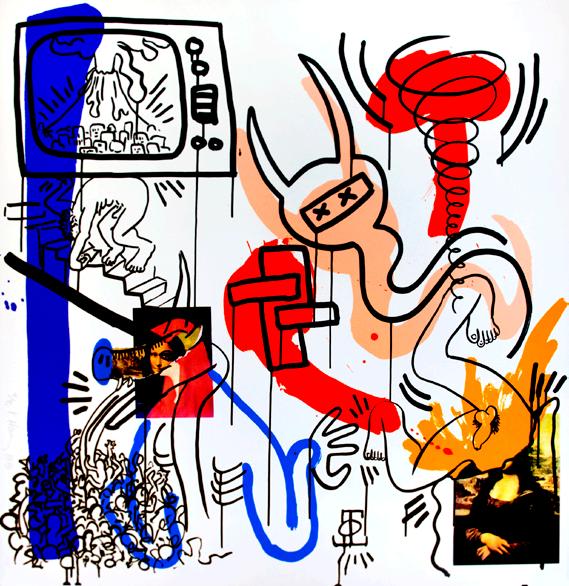

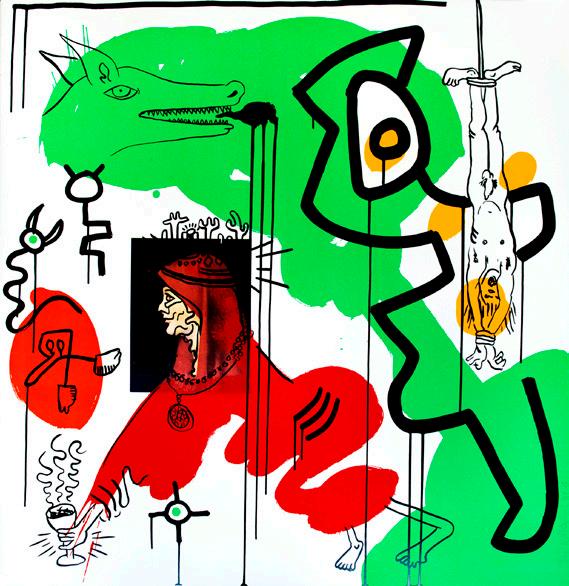
The complete set of 10 screenprints in colours, 1988, on Museum Board, with accompanying text by William Burroughs screenprinted on acetate, each sheet signed, dated and numbered from the edition of 90 in pencil (there were also 20 artist’s proofs and 5 hors commerce sets), published by George Mulder Fine Arts, New York, with the artist and publisher’s copyright inkstamps on the reverse, 96.5 x 96.5 cm. (38 x 38 in.)
[ref: 107959]




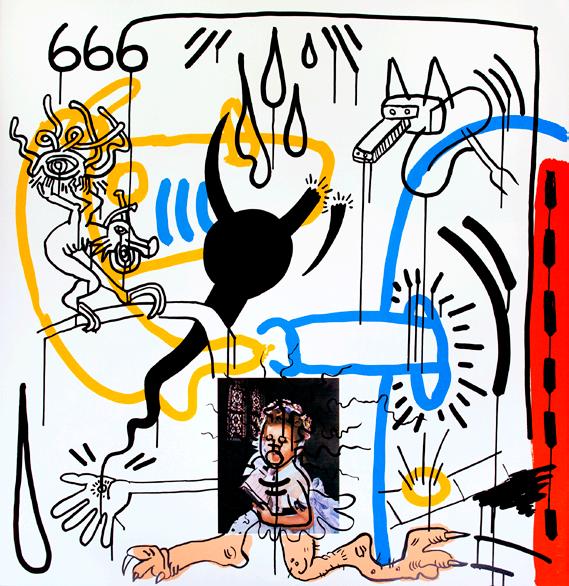

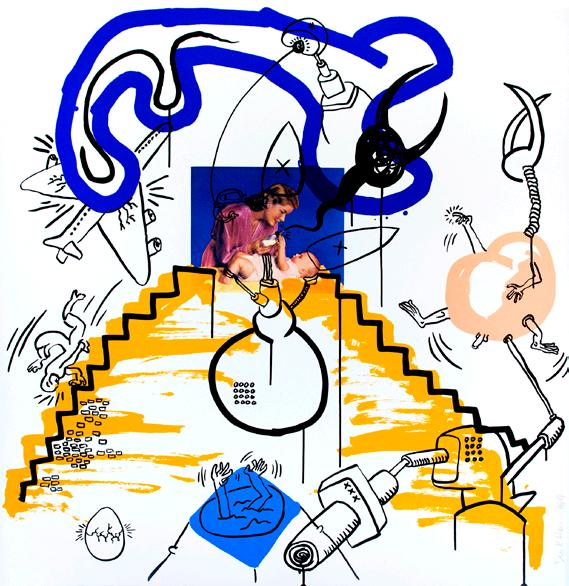
18. HOCKNEY, David. Paper Pools

Lithograph in colours, 1980, on Arches paper, signed and dated in pencil, numbered from the edition of 1000, printed and published by Tyler Graphics, Ltd., Mount Kisco, New York, with their blindstamp, accompanied by the numbered and signed book, ‘Paper Pools’, as issued, within the publisher’s blue cloth slipcase, 26.6 x 22.9 cm. (10¼ x 8¾ in.) Tokyo 234; Tyler 269 [ref: 109077]

Executed in the 1960s, “Ten from Leo Castelli” commemorates a historical moment. To honor the gallery’s tenth anniversary and the critical force it had played in cultivating American post-war art, artists including Andy Warhol, Jasper Johns, Frank Stella, Donald Judd, and Roy Lichtenstein each contributed to the portfolio. Here, Johns’s offering is “The Critic Sees,” a stirring interpretation of the relationship between connoisseurship, vision and language.
Embossing and screenprint, 1967, signed, titled and dated in pencil, numbered from the edition of 200, published by Tanglewood Press, New York, 60.96 x 50.8 cm. (24 x 20 in.) Field 39
[ref: 101218]
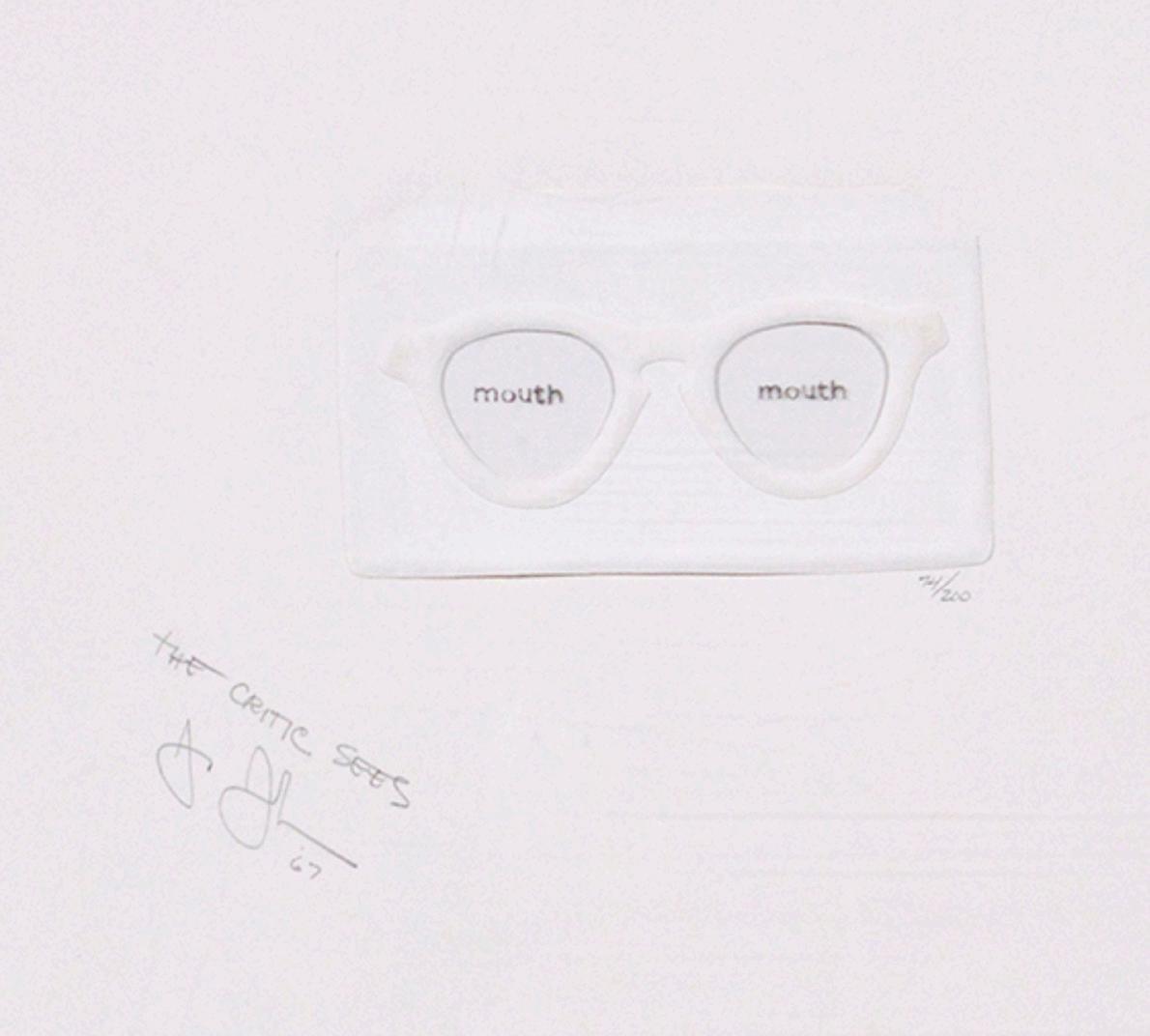 19. JOHNS, Jasper. The Critic Sees, from Ten from Leo Castelli portfolio 1967
19. JOHNS, Jasper. The Critic Sees, from Ten from Leo Castelli portfolio 1967
Archival pigment print, 2021, on Innova Etching Cotton Rag 315 gsm paper, signed in pencil, numbered from the edition of 100, published by Lococo Publishing, Missouri, 88 x 119 cm. (34¾ x 46¾ in.)
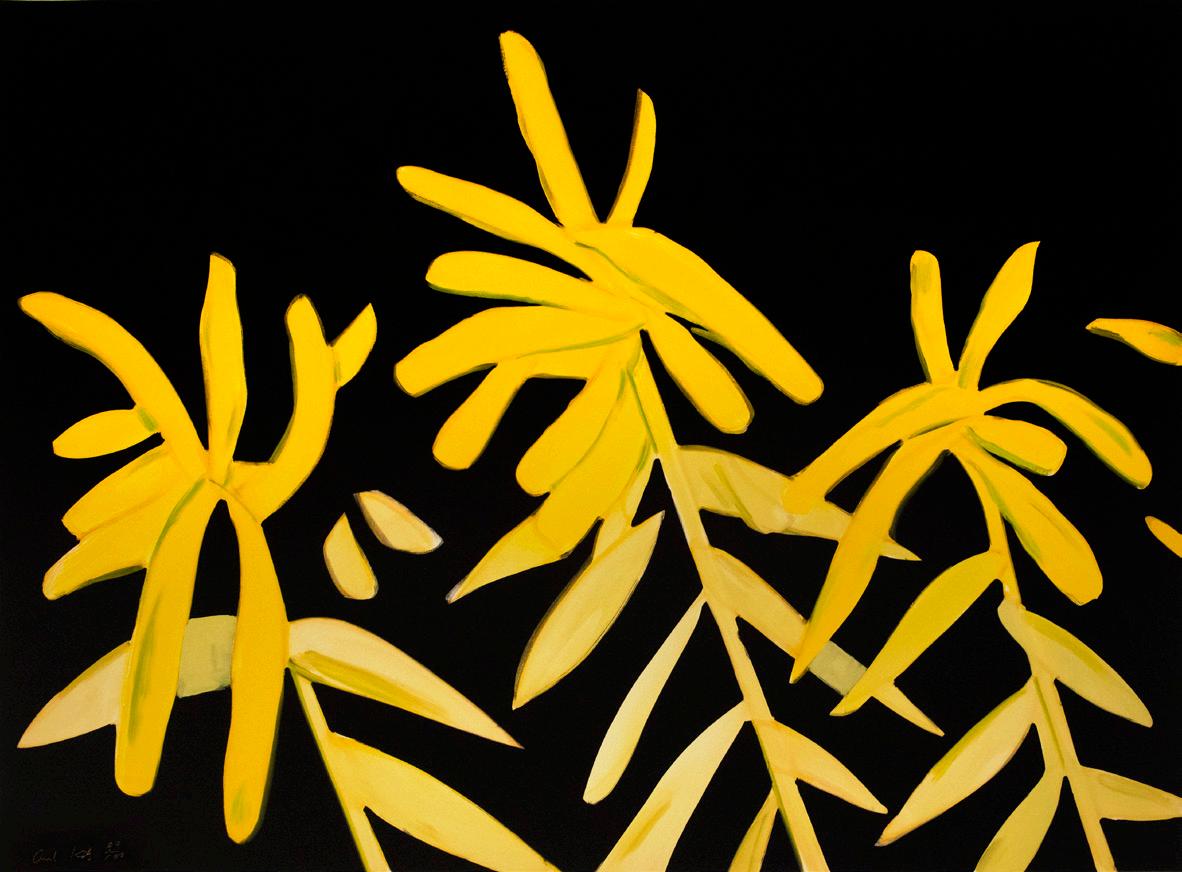
[ref: 105724]
Archival pigment print, 2021, on Innova Etching Cotton Rag 315 gsm paper, signed in pencil, numbered from the edition of 100, published by Lococo Publishing, Missouri 119 x 86 cm. (46¾ x 33¾ in.)
[ref: 105726]
20. KATZ, Alex. Goldenrod, from The Flowers Portfolio 2021
21. KATZ, Alex. Azaleas on Yellow, from The Flowers Portfolio 202

22. KOONS, Jeff. Balloon Dog (Blue)
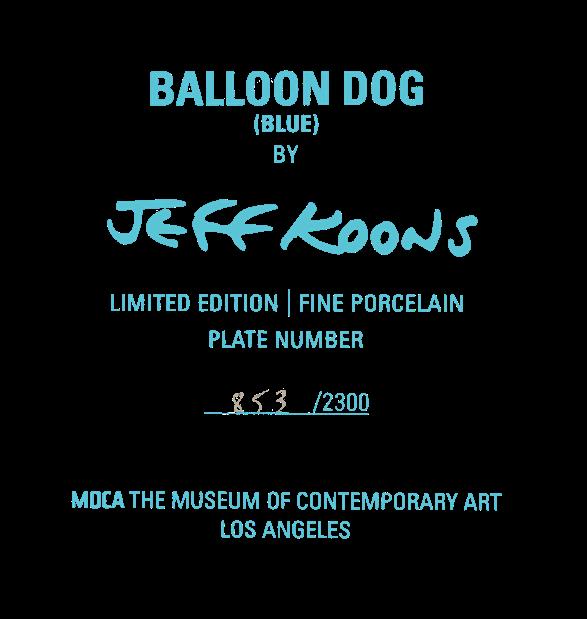
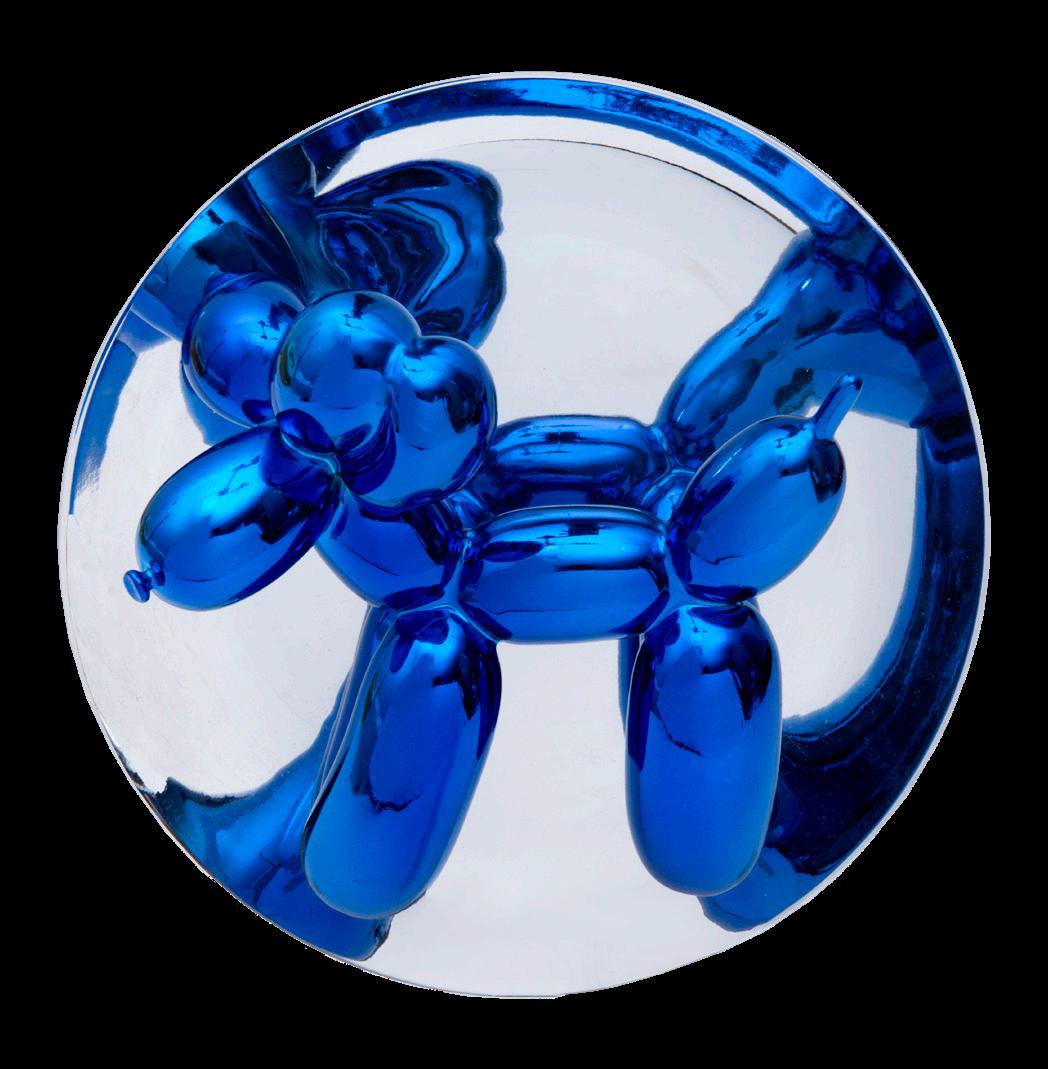
Porcelain multiple, 2002, numbered in black ink verso from the edition of 2300 (there were also 50 artist’s proofs) and with printed artist’s name as issued, published by The Museum of Contemporary Art of Los Angeles, with the original foam-lined cardboard box with plastic stand, diameter 26 cm. (10¼ in.)
[ref: 106843]
The artist’s aim was ‘to make a man look like a machine. It’s the machine quality of the twenties and thirties that interests me. The Art Moderne idea of making a head into something that looks as if it’s been made by an engineering draftsman deals with industrialization and manufacture, which is what my painting has dealt with since 61 or so’.

Lithograph in colours, 1970, on engraved aluminium, with incised signature and date on the reverse, numbered from the edition of 100, published by Gemini G.E.L., Los Angeles, with their copyright screenprint mark on the reverse, in the original aluminium frame, 53 x 44 cm. (20¾ x 17¼ in.) Corlett 94
[ref: 100611]
23. LICHTENSTEIN, Roy. Modern Head #4, from: Modern Head Series
A ground-breaking artwork and, with only 16 prints issued in the standard edition, a significant rarity.
 24. LICHTENSTEIN, Roy. Entablature III, from Entablature Series
24. LICHTENSTEIN, Roy. Entablature III, from Entablature Series
Screenprint and collage with embossing, 1976, on Rives BFK paper, signed and dated in pencil, one of nine artist’s proof, aside from the standard edition of 16, printed and published by Tyler Graphics Ltd., New York with their blindstamp, 74 x 114 cm. (29¼ x 45 in.) Corlett 140 [ref: 108005]

Screenprint in colours, 1973, on wove paper, stamped initialled by Roy Lichtenstein, from the edition of 380, published by Galerie Beyeler, 40.5 x 25 cm. (16 x 10 in.) Corlett III.46
[ref: 102637]
 25. LICHTENSTEIN, Roy. Flowers 25 Neujahrsgaben der Galerie Beyeler
25. LICHTENSTEIN, Roy. Flowers 25 Neujahrsgaben der Galerie Beyeler
26. LICHTENSTEIN, Roy. Illustration for ‘Hüm-Bum!’, from La Nouvelle Chute de l’Amérique
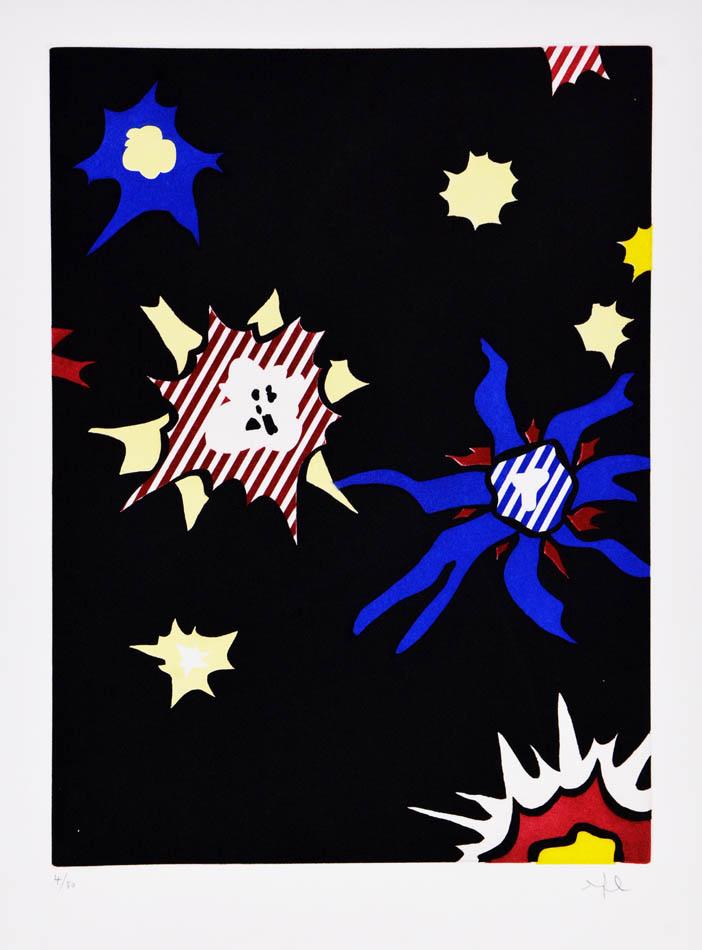
Etching with aquatint, 1992, on 250-gram Velin d’Arches paper, initialled and numbered from the edition of 80, printed by Atelier Dupont-Visat, L’Inediteur, Paris, published by Les Editions du Solstice, Paris, 35.4 x 48 cm. (14 x 19 in.)
Corlett 274
[ref: 101070]
Lithograph in colours, 1961, on BFK Rives wove paper, signed with the artist’s monogram in pencil, numbered from the edition of 75 (the total edition included 15 impressions numbered in Roman numerals), published by Galerie Maeght, Paris, 51 x 66.3 cm. (20 x 26 in.) Cramer Books 70 [ref: 105859]
Lithograph in colours, 1961, on BFK Rives wove paper, signed with the artist’s monogram in pencil, numbered from the edition of 75 (the total edition included 15 impressions numbered in Roman numerals), published by Galerie Maeght, Paris, 66.3 x 51 cm. (26 x 20 in.) Cramer Books 70 [ref: 105866]
 27. MIRO, Joan. Plate III, from Album 19 1961
28. MIRO, Joan. Plate IV, from Album 19 1961
27. MIRO, Joan. Plate III, from Album 19 1961
28. MIRO, Joan. Plate IV, from Album 19 1961

Lithograph in colours, 1961, on BFK Rives wove paper, signed with the artist’s monogram in pencil, numbered from the edition of 75 (the total edition included 15 impressions numbered in Roman numerals), published by Galerie Maeght, Paris, 51 x 66.2 cm. (20 x 26 in.) Cramer Books 70
[ref: 105856]
Lithograph in colours, 1961, on BFK Rives wove paper, signed with the artist’s monogram in black ink, numbered from the edition of 75 (the total edition included 15 impressions numbered in Roman numerals), published by Galerie Maeght, Paris, 66.5 x 51 cm. (26 1/4 x 20 in.) Cramer Books 70
[ref: 105867]
 29. MIRO, Joan. Plate VI, from Album 19 1961
30. MIRO, Joan. Plate X, from Album 19 1961
29. MIRO, Joan. Plate VI, from Album 19 1961
30. MIRO, Joan. Plate X, from Album 19 1961
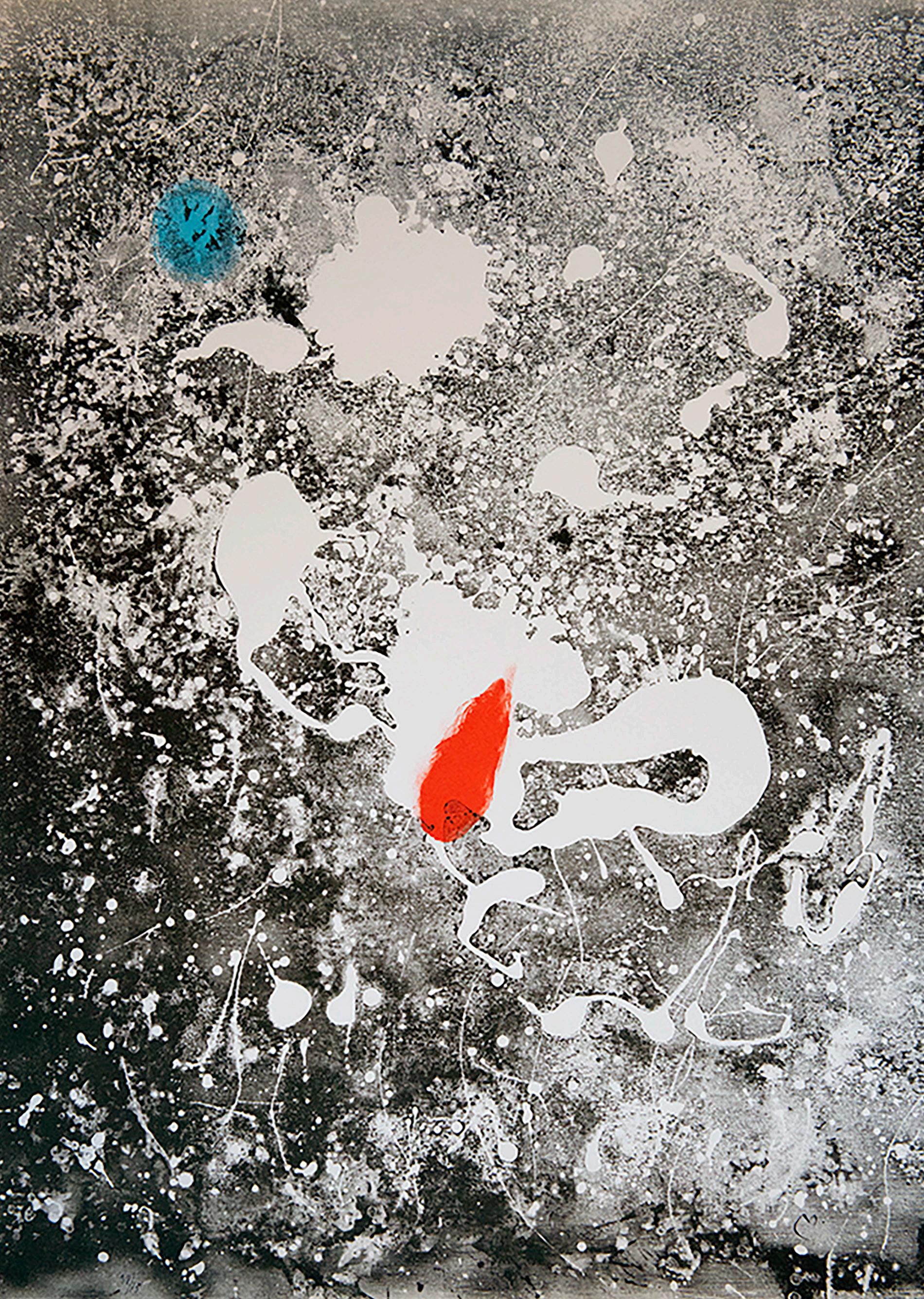
Lithograph in colours, 1961, on BFK Rives wove paper, signed with the artist’s monogram in pencil, numbered from the edition of 75 (the total edition included 15 impressions numbered in Roman numerals), published by Galerie Maeght, Paris, 51 x 66.3 cm. (20 x 26 in.) Cramer Books 70 [ref: 105861]
Lithograph in colours, 1961, on BFK Rives wove paper, signed with the artist’s monogram in pencil, numbered from the edition of 75 (the total edition included 15 impressions numbered in Roman numerals), published by Galerie Maeght, Paris, 66.2 x 51 cm. (26 x 20 in.) Cramer Books 70
[ref: 105862]
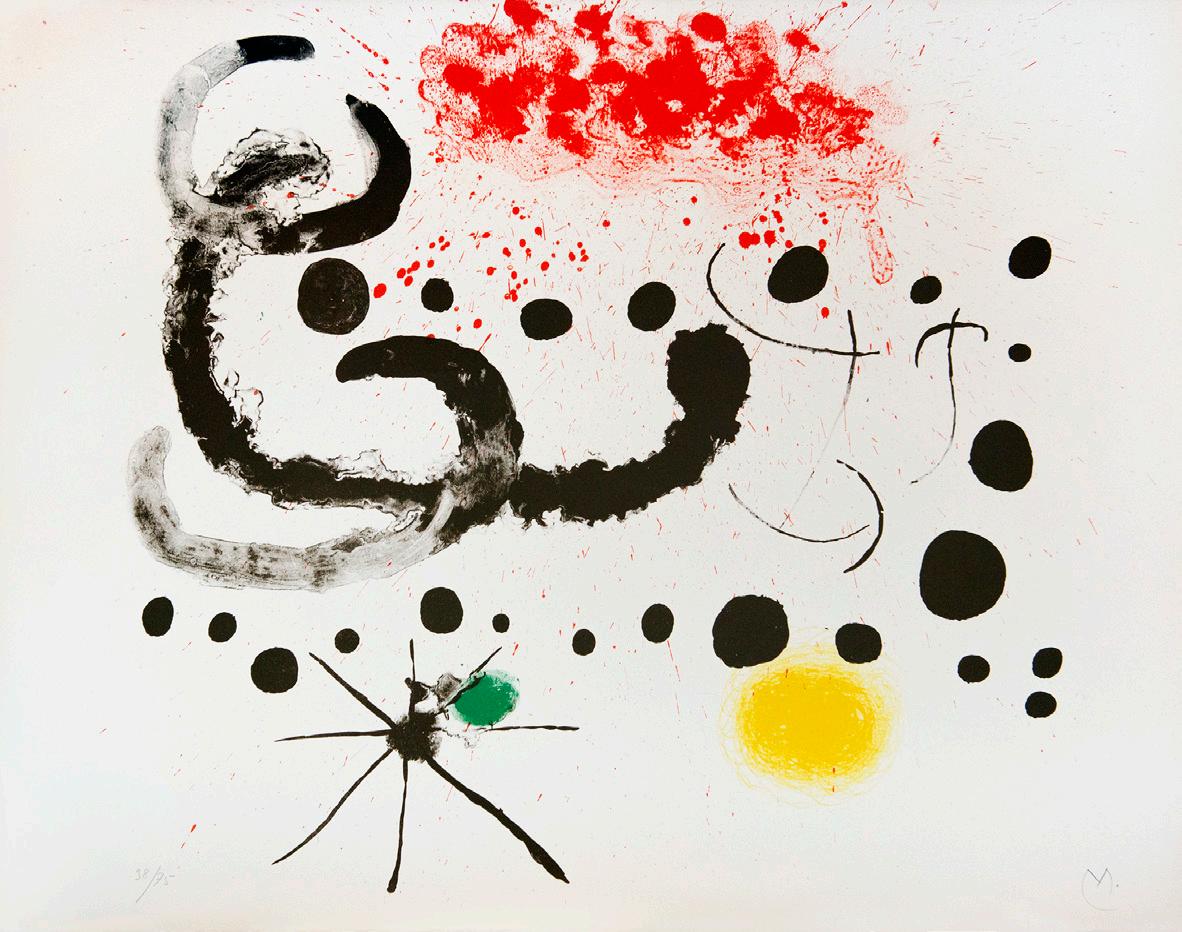 31. MIRO, Joan. Plate XII, from Album 19 1961
32. MIRO, Joan. Plate XIV, from Album 19 1961
31. MIRO, Joan. Plate XII, from Album 19 1961
32. MIRO, Joan. Plate XIV, from Album 19 1961
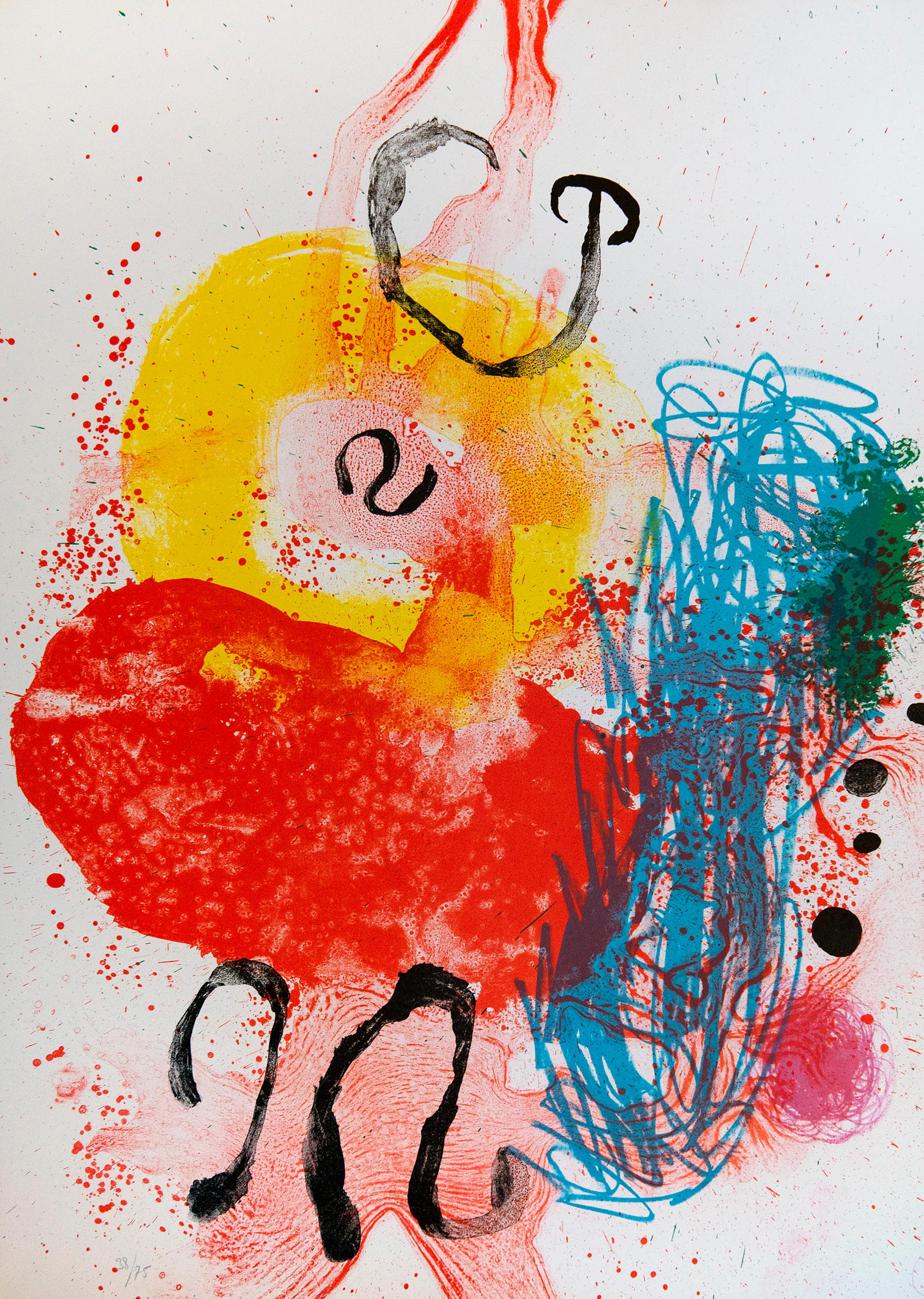
Lithograph in colours, 1961, on BFK Rives wove paper, signed with the artist’s monogram in pencil, numbered from the edition of 75 (the total edition included 15 impressions numbered in Roman numerals), published by Galerie Maeght, Paris, 51 x 66.4 cm. (20 x 26 in.) Cramer Books 70
[ref: 105860]
Lithograph in colours, 1961, on BFK Rives wove paper, signed with the artist’s monogram in pencil, numbered from the edition of 75 (the total edition included 15 impressions numbered in Roman numerals), published by Galerie Maeght, Paris, 66.3 x 51 cm. (26 x 20 in.) Cramer Books 70
[ref: 105864]
 33. MIRO, Joan. Plate XVI, from Album 19 1961
34. MIRO, Joan. Plate XIX, from Album 19 1961
33. MIRO, Joan. Plate XVI, from Album 19 1961
34. MIRO, Joan. Plate XIX, from Album 19 1961
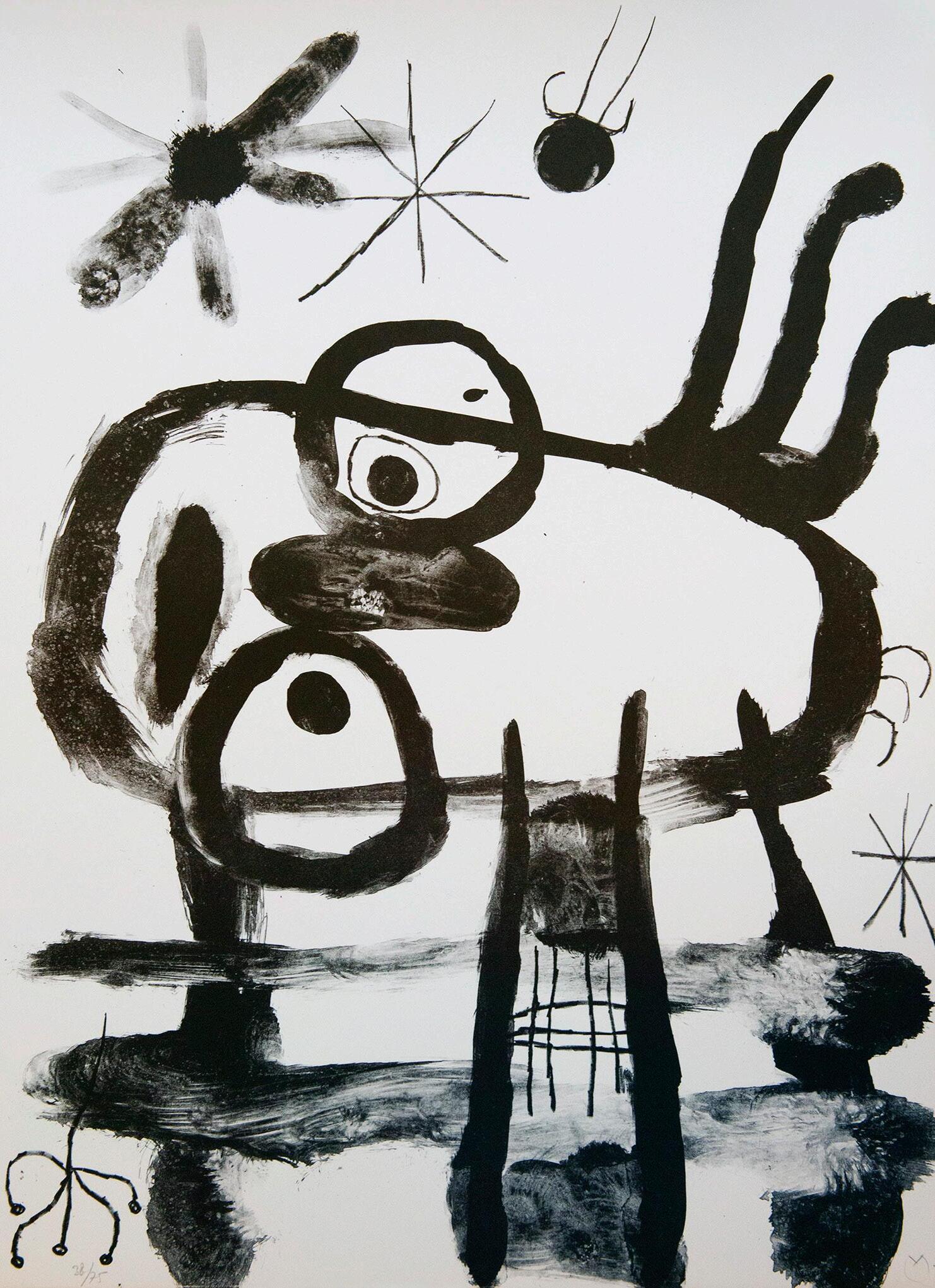
item 36
Miró’s vibrant and whimsical artwork depicting Alfred Jarry’s character Ubu amidst the colourful landscape of the Balearic Islands.


item 35
35-38. MIRO, Joan. 4 Plates from Ubu aux Baléares
item 37
item 38
Lithographs in colours, 1971, on Japon nacré paper, each signed in pencil, from the edition of 120, printed by Mourlot, published by Tériade, Paris, each 50.4 x 66.2 cm. (19¾ x 26 in.) Cramer Books 146

[ref: 106253, 106254, 106255 & 106256]
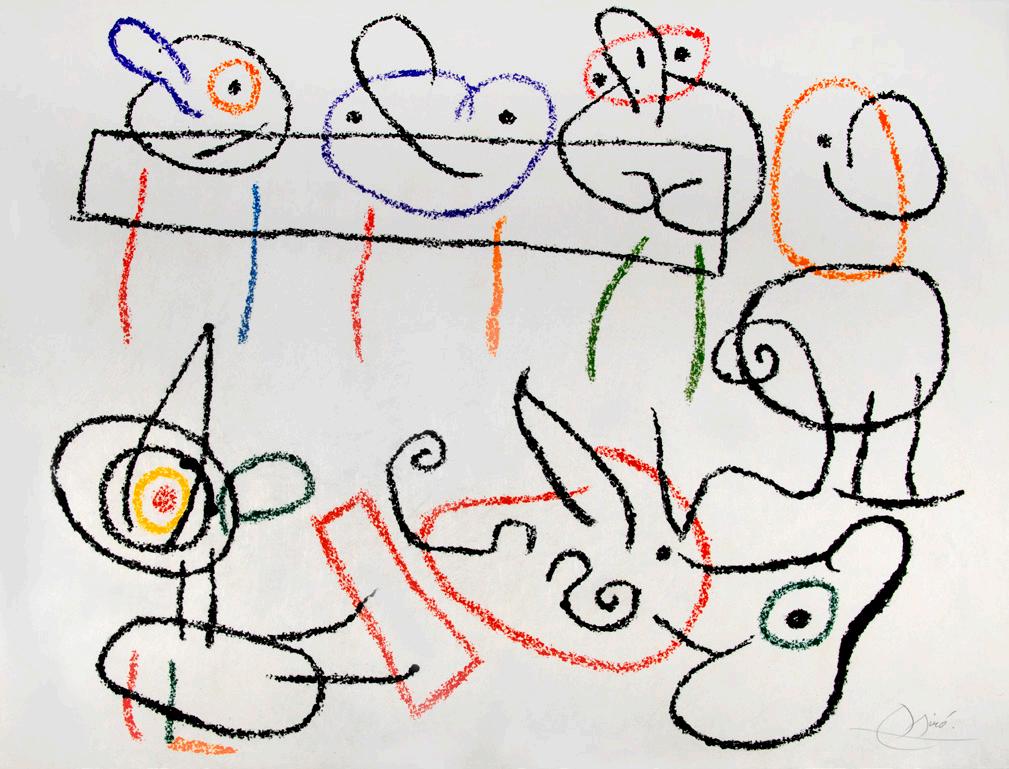
Pablo Picasso (1881-1973)
Pablo Picasso, born in Málaga, Spain, in 1881, is renowned for his profound influence on 20th-century art. His artistic evolution, marked by distinctive periods such as the Blue Period, Rose Period and the African Art-Inspired Period, were deeply intertwined with his personal experiences. Picasso’s relationships played a pivotal role in shaping his art, each igniting a new artistic phase with unique stylistic representations.
One such influential figure was Roger Lacourière, a renowned French printer and engraver, who played a significant role in Picasso’s development as a printmaker. He introduced Picasso to the complex process of intaglio printmaking, specifically the techniques of etching and aquatint. Their collaboration came to fruition in the Vollard Suite, a series of 100 etchings commissioned by the art dealer Ambroise Vollard.
In later years another significant influence was Picasso’s second wife, Jacqueline Roque. After meeting in 1953, Jacqueline came to represent tranquillity in his life, a theme mirrored in his art. With over 400 portraits of Jacqueline, this period was a testament to the profound impact she had on him as a muse. Her influence underscores the critical role of personal relationships in Picasso’s artistic evolution.
39. PICASSO, Pablo. Flûtiste et Jeune Fille au Tambourin, from The Vollard Suite
The present impression of Pablo Picasso’s Flûtiste et Jeune Fille au Tambourin is unquestionably amongst the rarest of works from the Vollard Suite. Dedicated to his friend Roger Lacourière who undertook the immense task of printing of the Vollard Suite, the work is also exquisitely hand coloured in red ink. This stunning, unique, example is one of only a very few known hand-coloured etchings by Picasso. The graceful brushstrokes deftly follow and enhance the delicate, sensual robes of the flûtiste and his muse, exemplifying great Picasso’s mastery of line. Hand-coloured etchings such as this were given by Picasso to only his closest friends and collaborators, they are rarely seen outside of museums and the finest of collections.
A rare etching, extensively hand-coloured in red ink by the artist, 1934, on wide margin Montval laid paper, signed, inscribed ‘For Lacourière’ and numbered 16/15 in the same red ink, 46 x 35.2 cm. (18.1 x 13.8 in.) Bridgette Baer states that Picasso signed and numbered 15 impressions of this work in red ink, she then cites this special hand-coloured 16th impression which was given by the artist to Roger Lacourière. Baer 412.
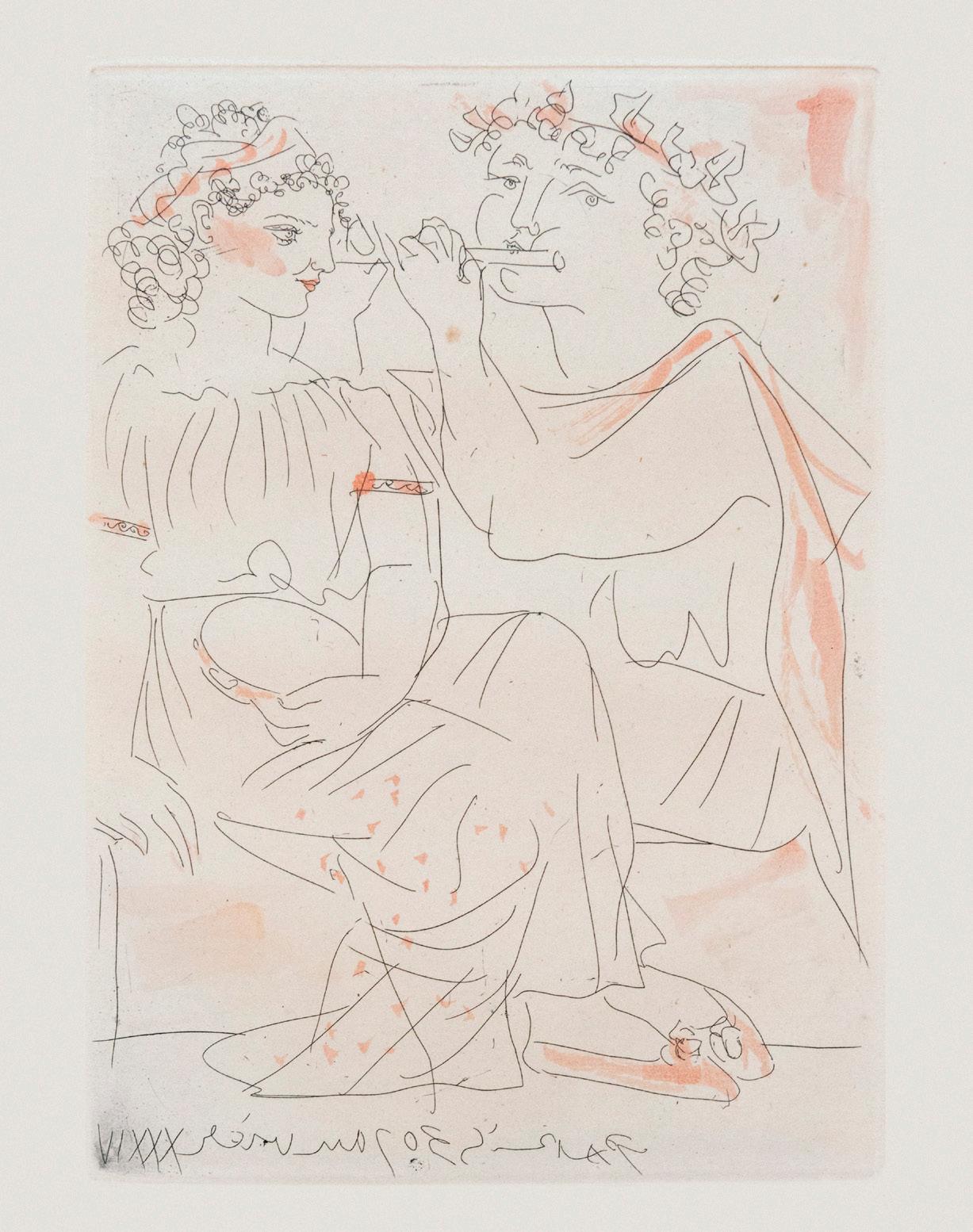
[ref: 107743]


Françoise Gilot was Pablo Picasso’s muse and lover during the period 1943-1953. In this lithograph, Picasso uses his simplified mark-making to capture her characteristic dark arching eyebrows, luscious locks and youthful doe-eyed face.
Lithograph, 14 June 1946, on Arches wove paper, signed in pencil by the artist, numbered from the edition of 50, 64 x 49.5 cm. (25¼ x 19½ in.) Bloch 399; Mourlot 43; Reuße 150.
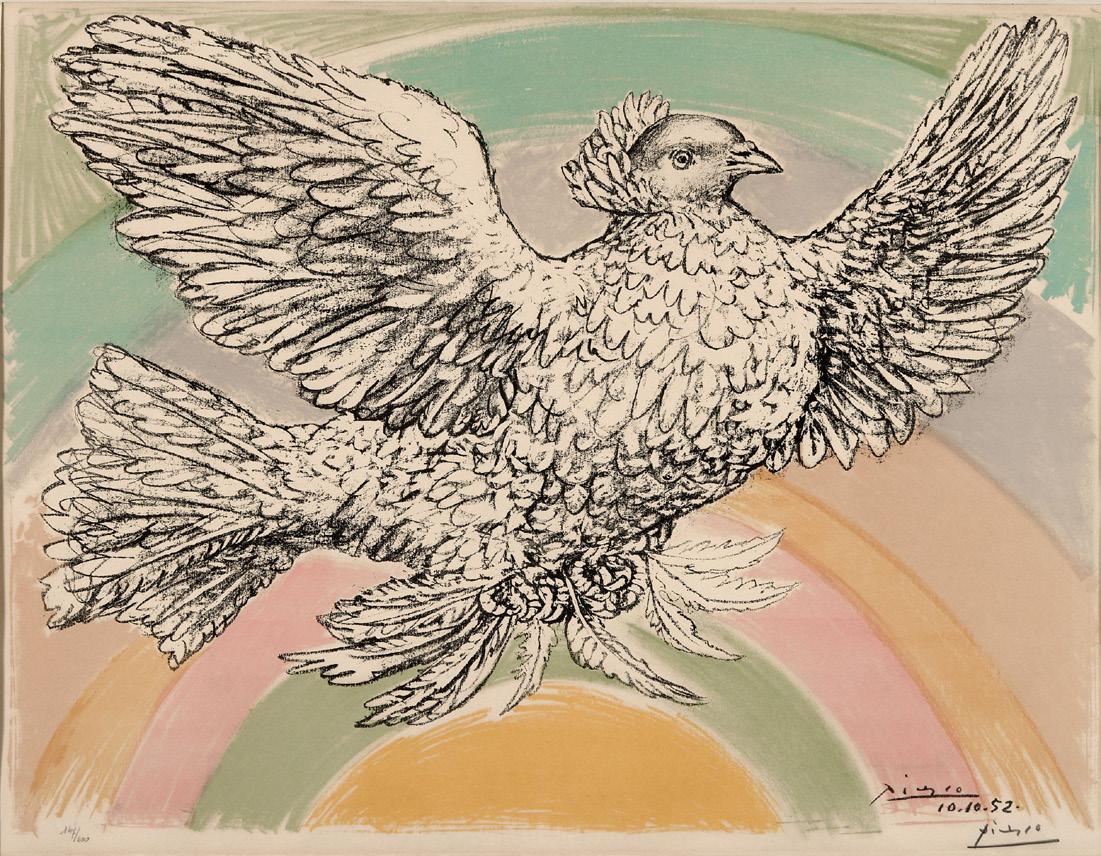
[ref: 107948]
Lithograph in colours, 1952, on Arches wove paper, signed in pencil, numbered from the edition of 200 (there were also 38 trial proofs), printed by Mourlot Freres, Paris, 55 x 76.5 cm. (21¾ x 30 in.)
Mourlot 214 ; Bloch 712; Reusse 598.
[ref: 109088]
40. PICASSO, Pablo. Françoise
41 PICASSO, Pablo. Colombe Volant (à l’Arc-en-Ciel)
PICASSO, Pablo. Portrait de Femme II
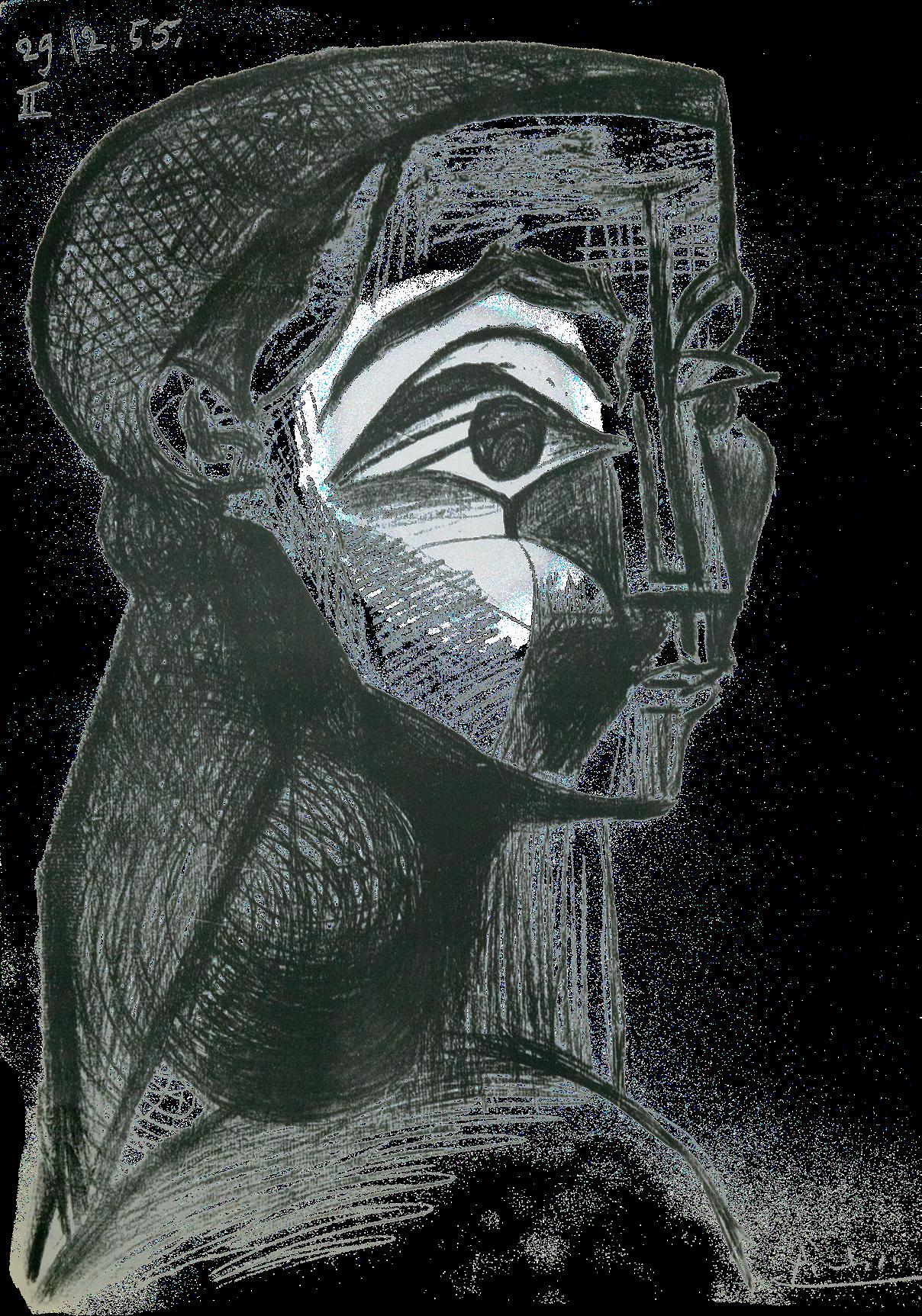
An Abstract threequarter profile of Picasso’s second wife, Jacqueline Roque.
Lithograph, 1955, on Arches wove paper, signed in pencil and numbered from the edition of 50, printed by Mourlot, Paris, published by Galerie Louise Leiris, Paris, 66.4 x 50 cm. (26⅛ by 19¾ in.) Bloch 780; Mourlot 272
[ref: 107075]
Linocut in colours, 1959, on watermarked Arches paper, signed in pencil, an artist’s proof aside from the standard edition of 50, printed by Imprimerie Arnéra, published by Galerie Louise Leiris, 75.1 x 62.1 cm. (29½ x 24½ in.) Bloch 0914; Baer 1242 third state of three, III.b (of C)
[ref: 107708]
 43. PICASSO, Pablo. Bouquet dans un Vase
43. PICASSO, Pablo. Bouquet dans un Vase
Linocut in colours, 1962, on watermarked Arches paper, signed in pencil, an artist’s proof (Baer records 3-4 such impressions), aside from the standard edition of 50, printed by Imprimerie Arnéra, published by Galerie Louise Leiris, 75.3 x 62 cm. (29¾ x 24½ in.)

Bloch 1069; Baer 1303, third state of three B.b (of B.b.)
[ref: 107709]
44. PICASSO, Pablo. Jacqueline au Bandeau de Face
This portrait of Jacqueline Roque forms part of a series of linocut portraits created between 1961-62 with Master Printmaker Hidalgo Arnéra.
Etching and aquatint in colours, 1964, on Richard de Bas laid paper with the Auvergne watermark, signed in pencil, numbered from the edition of 50, 56.2 x 40.6 cm. (22¼ x 16 in.) Bloch 1167; Baer 1167.
[ref: 107723]
 45. PICASSO, Pablo. Fumeur à la Cigarette Rouge (B., BA. 1167)
45. PICASSO, Pablo. Fumeur à la Cigarette Rouge (B., BA. 1167)


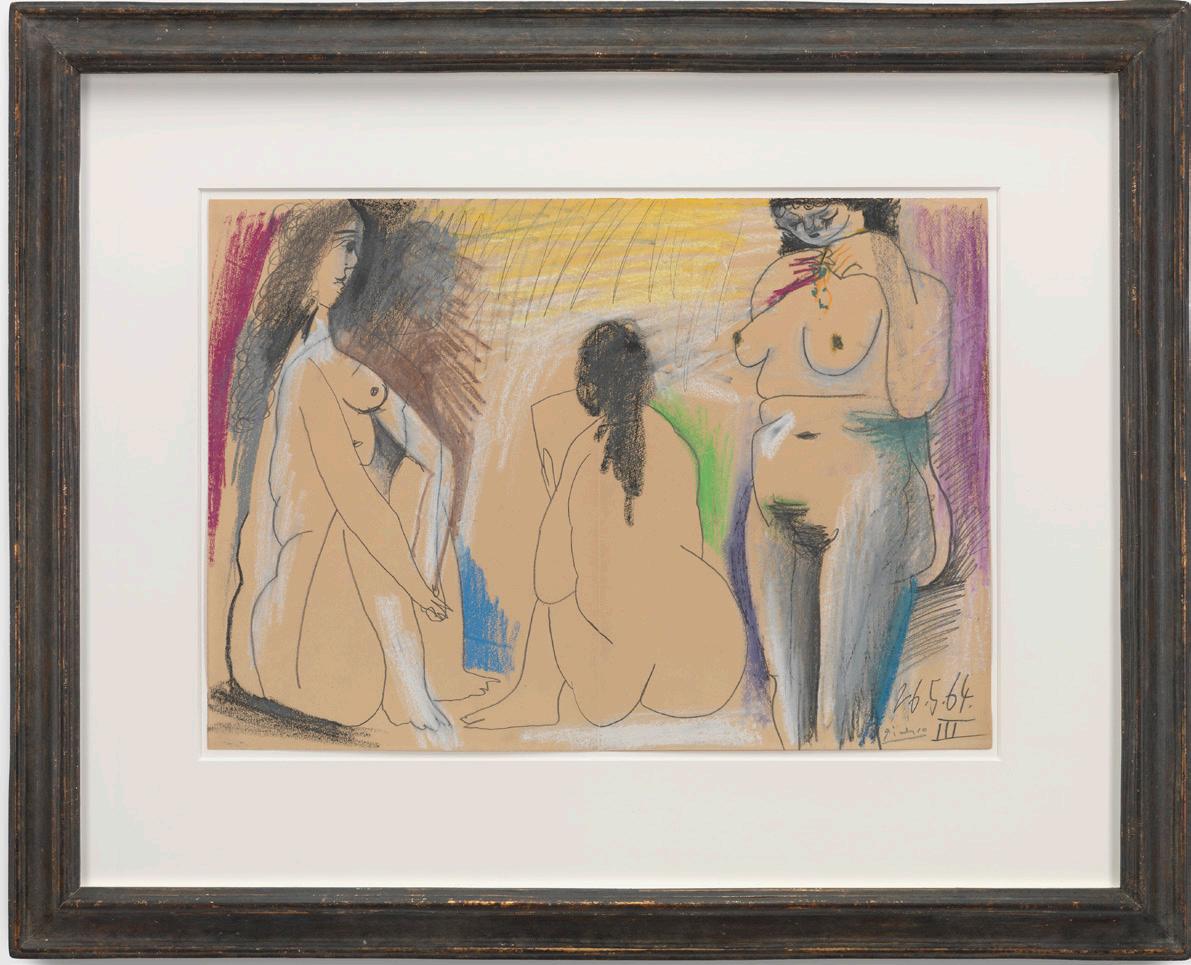
 PICASSO, Pablo. Trois nus
PICASSO, Pablo. Trois nus
In 1964, Picasso, age 83, moved to Notre-Dame-de-Vie in the south of France with his second wife Jacqueline Roque and began a series of works using an unyieldingly powerful line, as seen in the drawing ‘Trois Nus’, 1964.
‘Trois Nus’ is a strong graphic image exploring one of the most enduring themes within Picasso’s oeuvre, the nude. The composition is effortlessly balanced with a seated central figure framed by a crouching and standing nude on either side. The vibrant colours Picasso used in this sensual drawing strike a delicate balance between the art-historical significance and the raw sensuality of his nudes. In this work he takes the female figure back to something more timeless, enduring and primordial. As Susan Galassi notes the female nude was for Picasso, ‘the very essence of art... It’s principle and its force, the mysterious armature that prevents its decomposition and dissolution. She is equated with the originating impulse of art, eros, inspiration, and generativity, and is the link between generations.’
This drawing also presents us with the vestige of a life committed to exploring themes related to the nature of looking. The central figure in ‘Trois Nus’ references that of the artist, although her gesture is hidden from us, it appears as though she holds a canvas and is sketching out a scene. The curvaceous figures to either side, marked out with strong lines and colours of unprecedented vividness also held great personal significance to Picasso, as they are understood to be thinly veiled references to his wife, Jacqueline. As was the case for many of the female figures Picasso depicted at the end of his career, the women in this composition with their full dark hair and large eyes bear a striking resemblance to his wife. Although Picasso never had her pose for him in his studio, her image dominated the artist’s pictures in the last decades of his life.
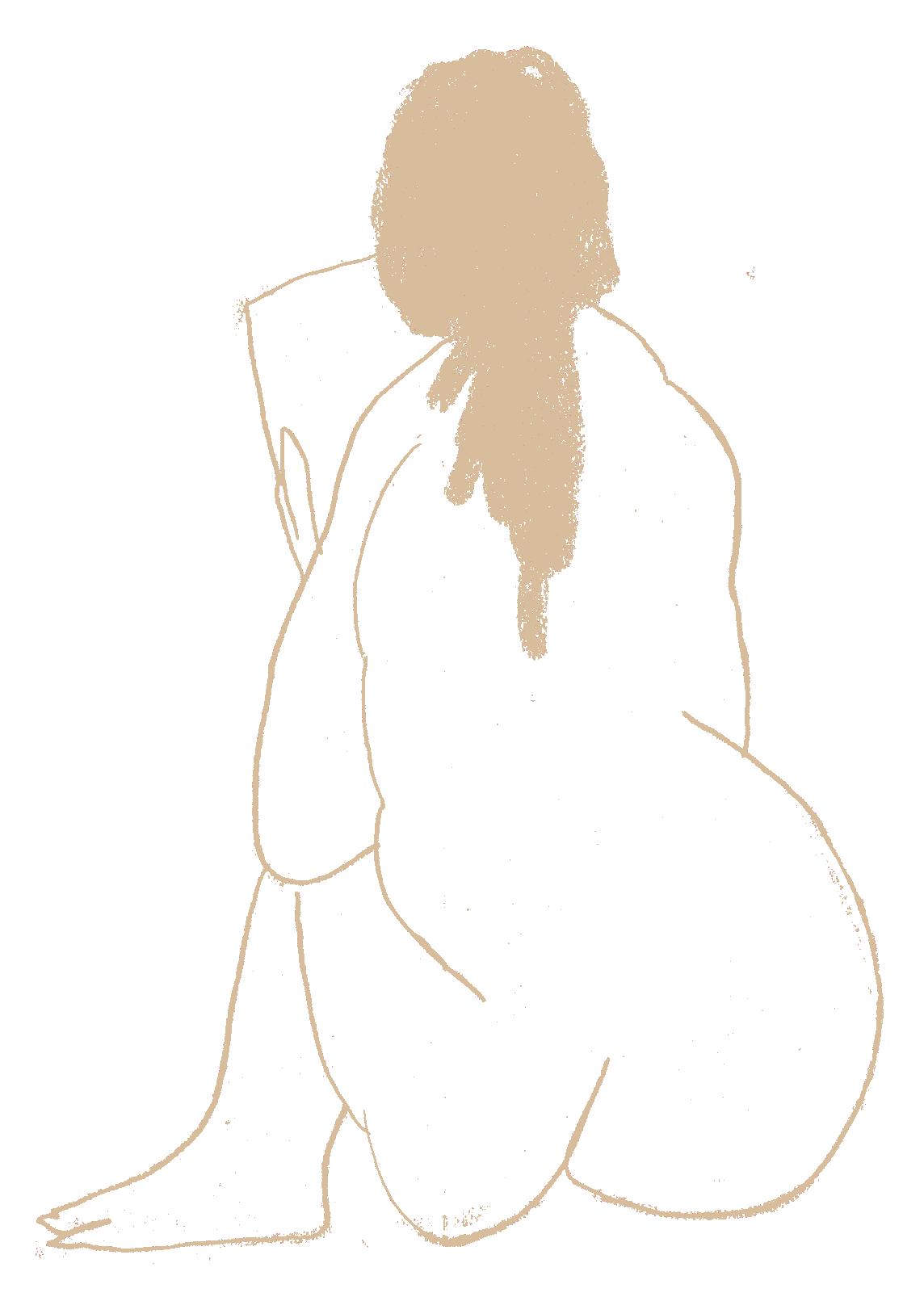
A unique work, graphite and crayon on paper, 1964, signed and dated lower right: ‘26.5.64 Picasso III’, 52 x 74 cm. (20 1⁄2 x 29 1⁄4 in.). This work is accompanied by a certificate kindly issued by Claude Ruiz-Picasso dated 28 November 2013.
[ref: 108982]
46.
Le Cocu Magnifique is a farcical play written by Belgian dramatist Fernand Crommelynck about a jealous man, Bruno, who – because of this jealously – ends the play by losing his wife, Stella. Bruno is the kind of man who sees an enemy in the other sex; he seeks to control a woman, but he can never obtain this dominance because the female soul eludes him. It is because he cannot bear Stella’s love that he will in the end be cuckolded. The play premiered in Paris in December 1920 and in 1968, Picasso produced a series of 12 etchings and aquatints based on the play’s text. Picasso and Crommelynck knew each other for many years, and for some time Picasso had intended to illustrate the play. Picasso’s dramatic and often explicit depiction of Crommelynck’s story is well suited to the stark black and white media of aquatint and etching.
Etchings, 1968, on Auvergne Richard-de-Bas wove paper, each signed in pencil and numbered from the edition of 30, printed & published by Atelier Crommelynck, Paris, 37 x 47.8 cm. (14½ x 18¾ in.) B. 12441255; BA. 1432-1443; C. BKS 140
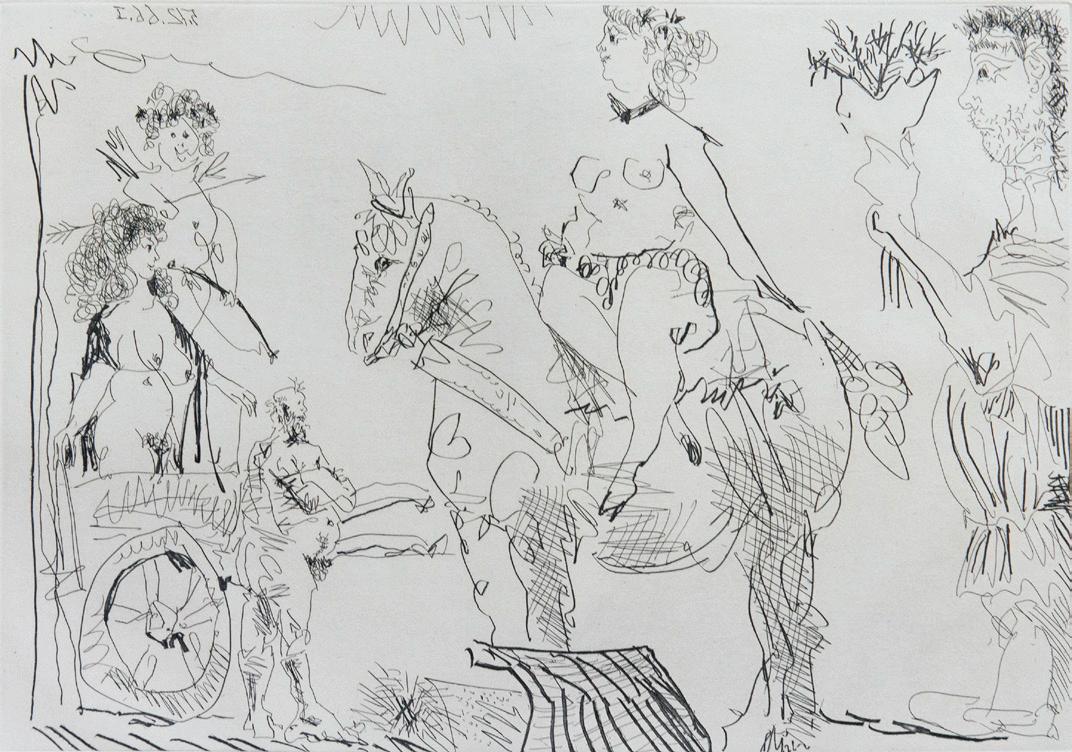 47. PICASSO, Pablo. Plate 2, from Le Cocu Magnifique [ref: 106682]
47. PICASSO, Pablo. Plate 2, from Le Cocu Magnifique [ref: 106682]
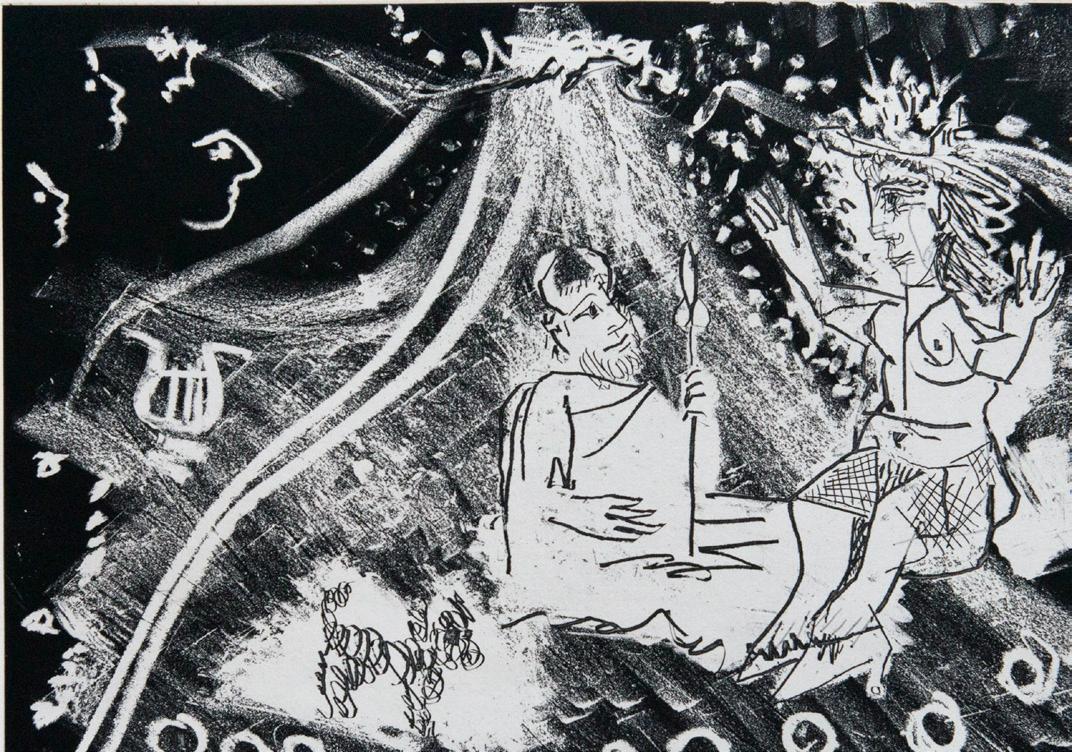
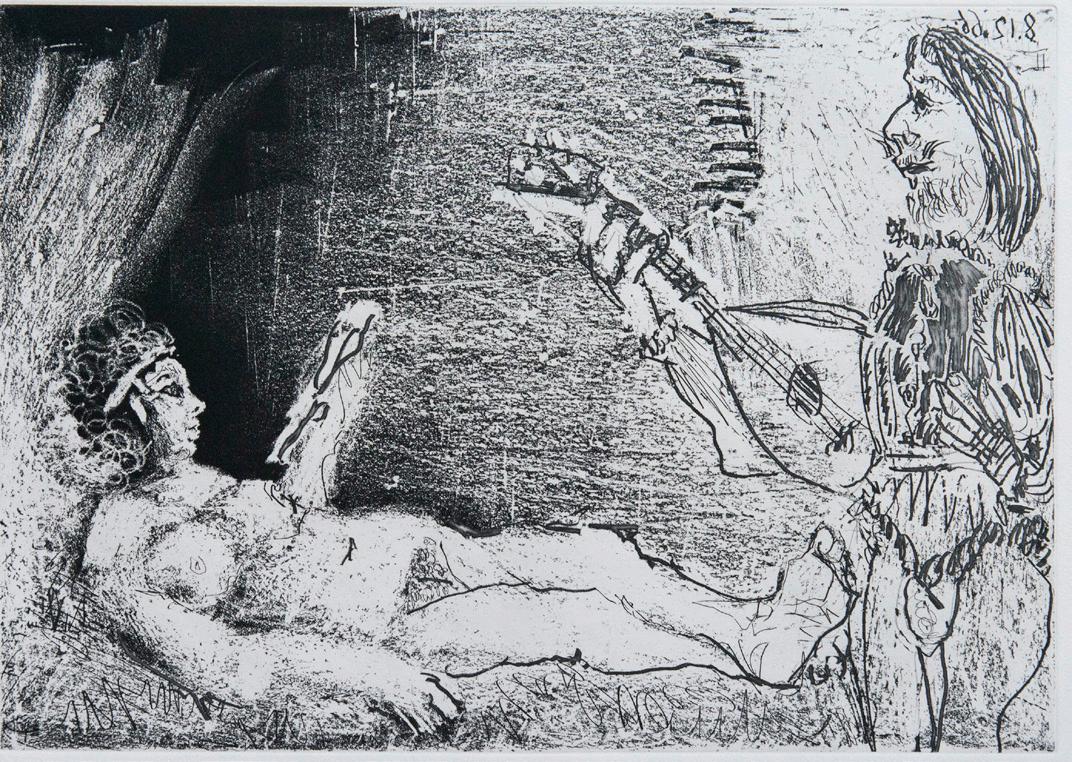 48. PICASSO, Pablo. Plate 4, from: Le Cocu Magnifique [ref: 106681]
49. PICASSO, Pablo. Plate 10, from: Le Cocu Magnifique [ref: 106679]
48. PICASSO, Pablo. Plate 4, from: Le Cocu Magnifique [ref: 106681]
49. PICASSO, Pablo. Plate 10, from: Le Cocu Magnifique [ref: 106679]
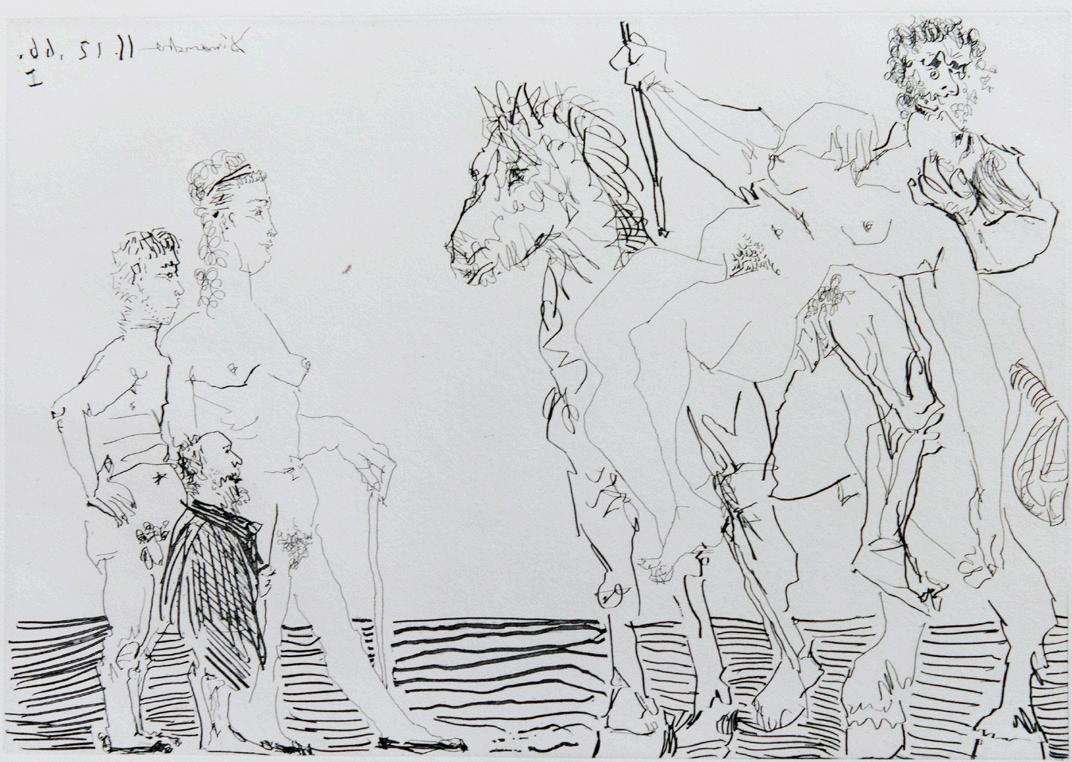
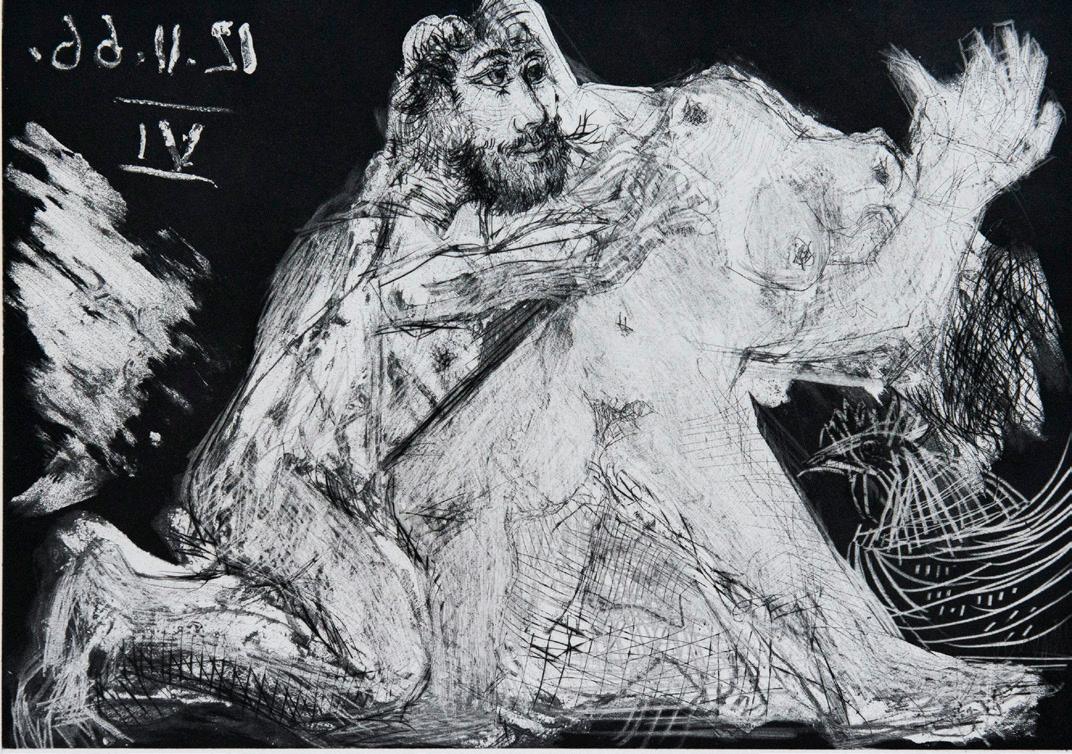 50. PICASSO, Pablo. Plate 11, from: Le Cocu Magnifique [ref: 106680]
51. PICASSO, Pablo. Plate 12, from: Le Cocu Magnifique [ref: 106678]
50. PICASSO, Pablo. Plate 11, from: Le Cocu Magnifique [ref: 106680]
51. PICASSO, Pablo. Plate 12, from: Le Cocu Magnifique [ref: 106678]
52. PICASSO, Pablo (After). Bacchanale

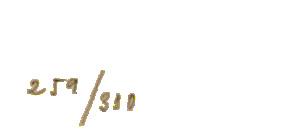
Aquatint in colours, circa 1955, on Rives BFK wove paper, signed in pencil and numbered from the edition of 300, published by Atelier Crommelynck, Paris, with their blindstamp, 56 x 76.5 cm. (22 x 30 in.)

A collection of lithographs from the series Les Portraits Imaginaires.
Lithographs in colours, 1969, on wove paper, with the artist’s printed signature as issued, all except the first numbered from the French edition of 250 and inscribed with an ‘F’ (there was also an American edition of 250 marked ‘A’), printed and published by Éditions Cercle D’art/Marcel Salinas, Paris, with their blindstamp, 65 x 50 cm. (25½ x 19¾ in.)
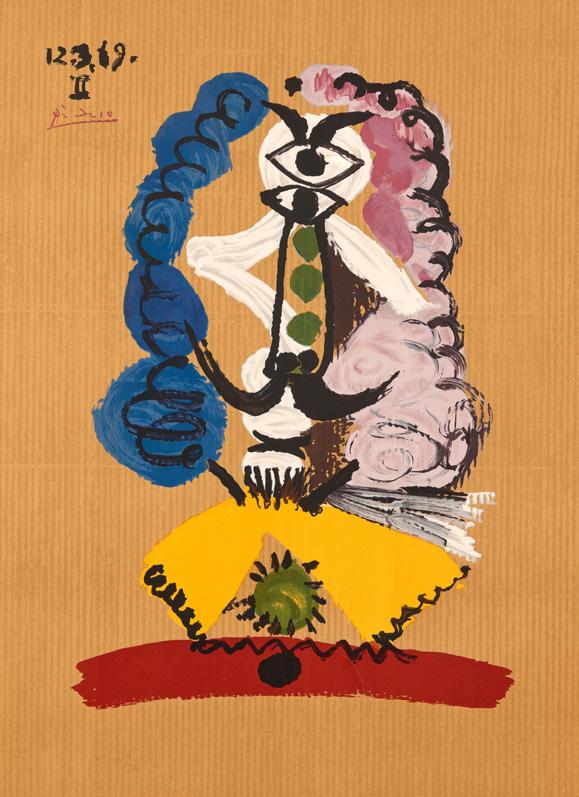
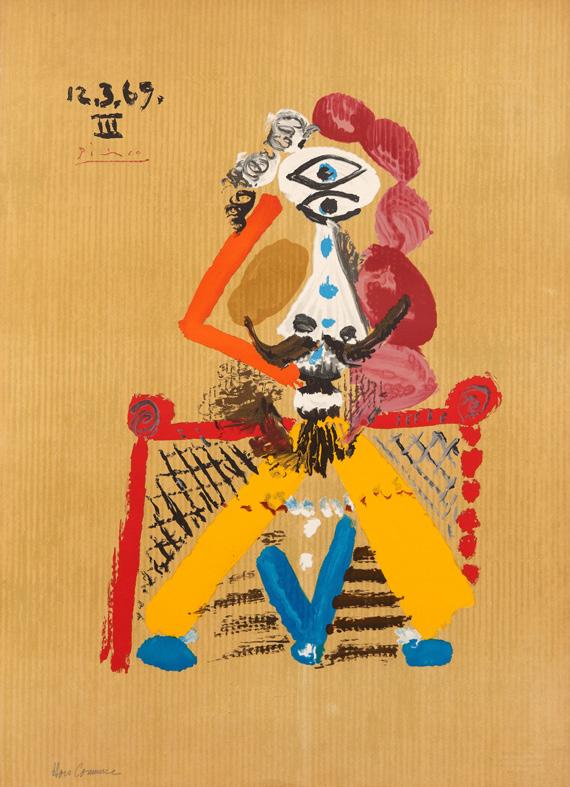
[ref: 109090]
Inscribed ‘Hors Commerce’, aside from the French ‘F’ edition of 250.
[ref: 109091]
53. PICASSO, Pablo (After). Les Portraits Imaginaires: One Plate
54. PICASSO, Pablo (After). Les Portraits Imaginaires: One Plate
[ref: 109092]
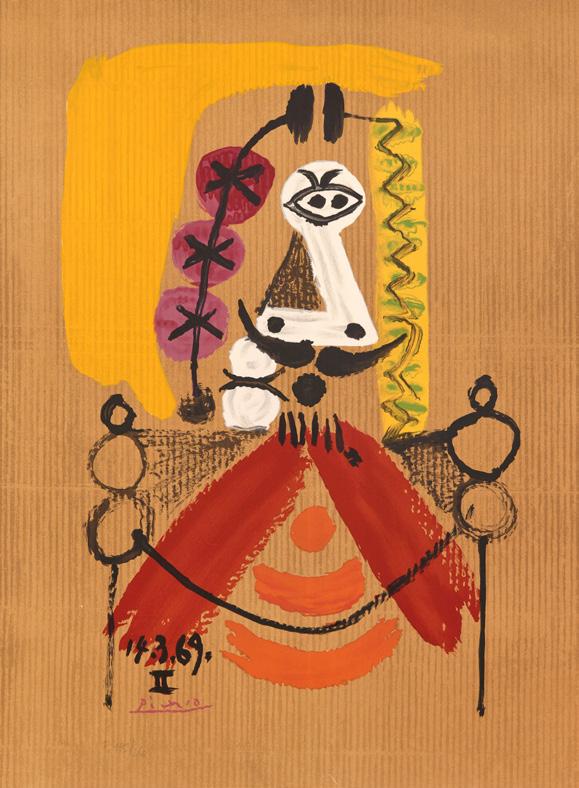


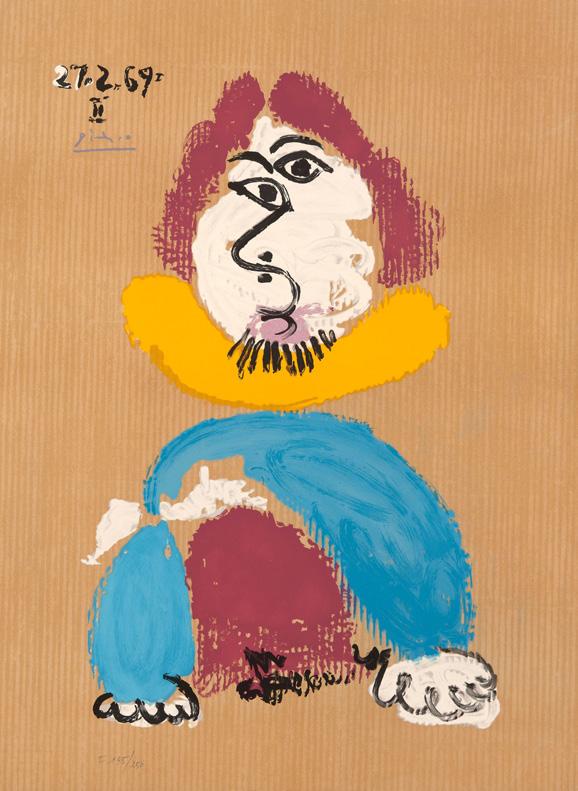
[ref: 109093]
[ref: 109095]
109096]
55. PICASSO, Pablo (After). Les Portraits Imaginaires: One Plate
56 PICASSO, Pablo (After). Les Portraits Imaginaires: One Plate
57. PICASSO, Pablo (After). Les Portraits Imaginaires: One Plate
58. PICASSO, Pablo (After). Les Portraits Imaginaires: One Plate [ref:
59. STELLA, Frank. Fortin de las Flores (First Version)
For this screenprint, Stella first submitted a gouache based on the painting Fortin de las Flores from the Concentric Squares and Mitered Mazes series of 1962-63. A second version of this image was created as a lithograph for the four-part series Jasper’s Dilemma (1973).

Screenprint, 1967, on English Vellum Graph paper, signed and dated in pencil, numbered from the edition of 200, printed by Fine Creations, Inc., New York, published by Tanglewood Press, New York, 46 x 58.4 cm. (18 1/8 x 23 in.) Axsom 0
[ref: 102362]
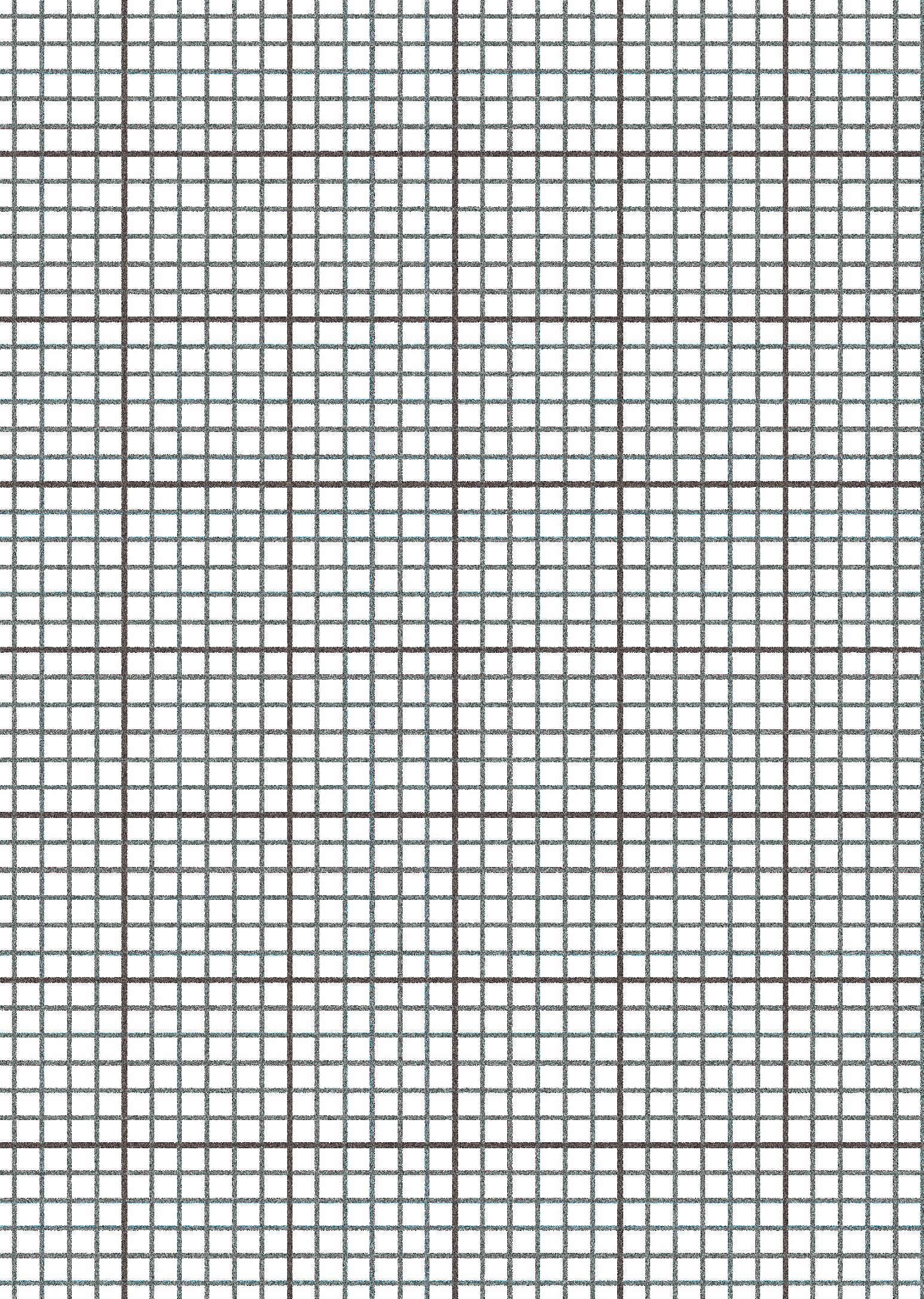
60. STELLA, Frank. Ifafa I, from the V Series 8
From the V series of lithographs, Ifafa I is one of the set based on the stripe paintings of the Notched V Paintings (1964-65).

Lithograph with varnish, 1968, with LC Varnish on Lowell paper, signed, dated and numbered from the edition of 100, published by Gemini G.E.L., Los
Angeles, 41.3 x 56.8 cm. (16¼ x 22¼ in.) Axsom 21
[ref: 103137]
61. STELLA, Frank. Empress of India II, from the V Series 1968
Lithograph in colours, 1968, on Lowell paper, signed and dated in pencil, numbered ‘A.P.’, one of 15 artist’s proofs, aside from the standard edition of 100, published by Gemini G.E.L., Los Angeles, 41.3 x 89 cm. (16¼ x 35 in.) Axsom 28
[ref: 103227]
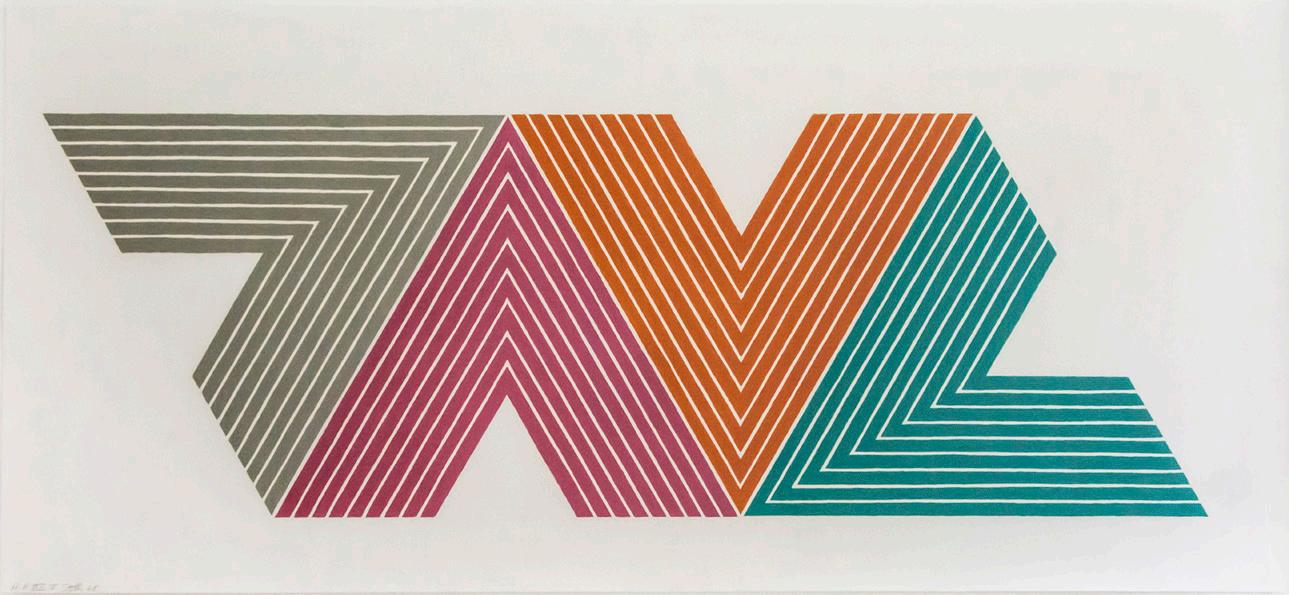
62. STELLA, Frank. Grodno (I), from Paper Reliefs
The series ‘Paper Reliefs’ is based on the earlier ‘Polish Village Series’ (1971-73) with the use of relief elements to create the geometric structures which pay homage to the complex architecture of Soviet and Polish wooden synagogues from 16th, 17th and 18th century. The present work ‘Grodno (I)’, along with the other five reliefs, was a breakthrough series for Frank Stella – it was the first insinuation of colour into paper and the achievement of relief in his prints.

Unique cotton-pulp relief with collage and hand-colouring, on white and coloured HMP handmade paper, 1975, signed and dated in pencil, from the edition of 26 uniquely hand-coloured reliefs (there were also 14 trial proofs), published by Tyler Graphics, Ltd., New York, with their blindstamp, 64 x 54 cm. (25¼ x 21¼ in.) Axsom 106.1
[ref: 108004]
Unique cotton-pulp relief with hand-colouring and collage, 1975, on coloured HMP handmade paper, signed, dated and annotated ‘T.P’ in black ink on the reverse, one of 14 unique colorway trial proofs, aside from the edition of 26, published by Tyler Graphics Ltd, Bedford Village, New York, 63.6 x 52.7 x 4 cm. (25 x 20¾ x 15/8 in.) Tyler Graphics 546; Axsom 106.5
[ref: 108988]
 63. STELLA, Frank. Lunna Wola (V), from Paper Reliefs
63. STELLA, Frank. Lunna Wola (V), from Paper Reliefs
64. STELLA, Frank. Shards II
Frank Stella’s Shards Series, 1982, is comprised of five lithographs and four variants. The fascinating grid systems that make up the backdrop of Shards were adapted from the plates of Polar Coordinates, and the various French curves and undulating lines echo the forms seen in Circuits. In Shards II, these forms interact with one another, almost granting physical sensations and movement to the piece. Shards II beautifully employs negative space to accentuate the rich texture.
Lithograph and screenprint in colours, 1982, on Arches paper, signed and dated in pencil, numbered from the edition of 100 (there were also 20 artist’s proofs), published by Petersburg Press, New York, 101.1 x 115 cm. (39¾ x 45¼ in.) Axsom 145
[ref: 106400]
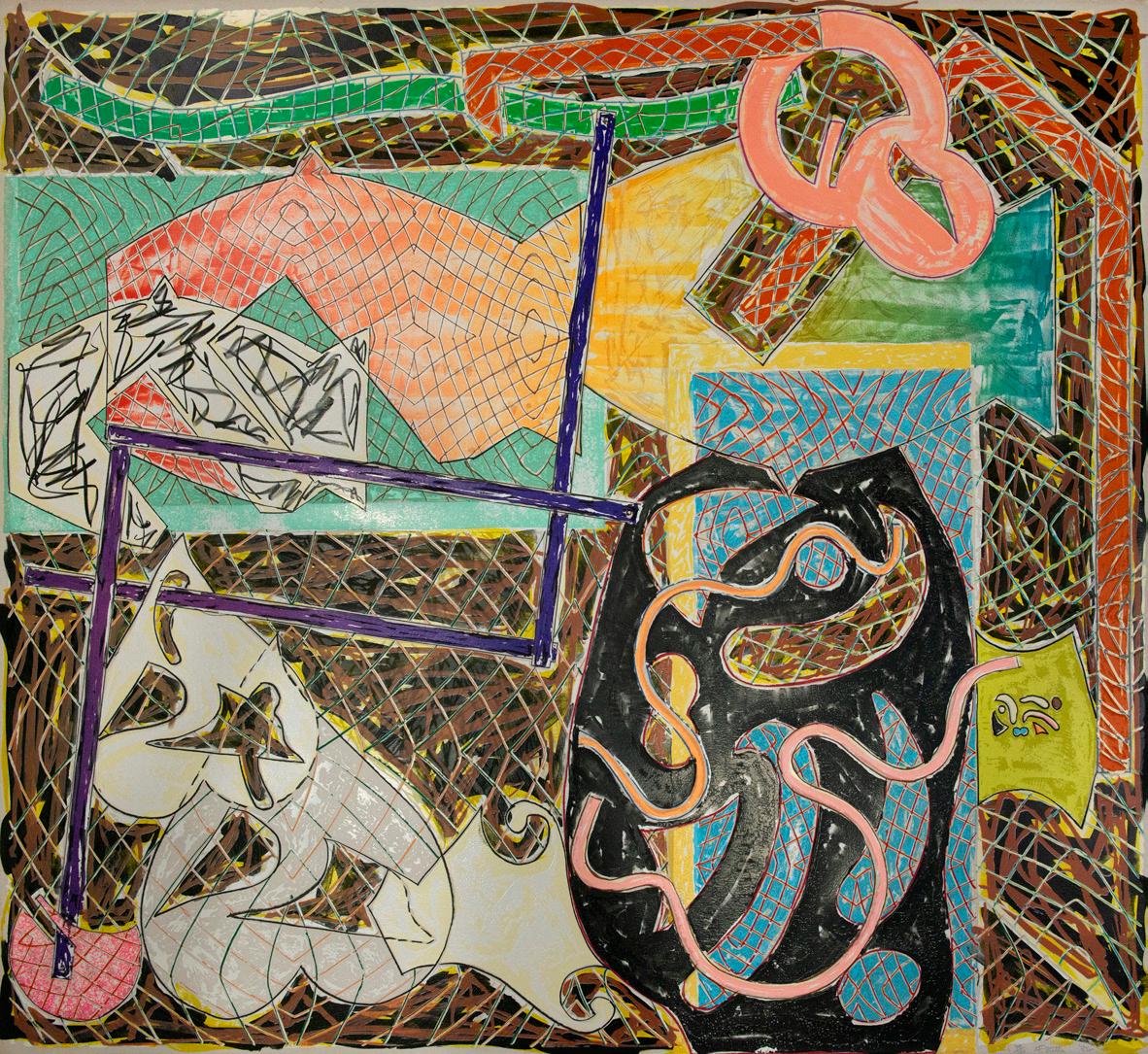
Lithograph and screenprint in colours, 1982, on Arches Cover Paper, signed and dated in pencil, numbered from the edition of 100, published by Petersburg Press, New York, 114.9 x 101 cm. (45¼ x 39¾ in.) Axsom 146 [ref: 101733]
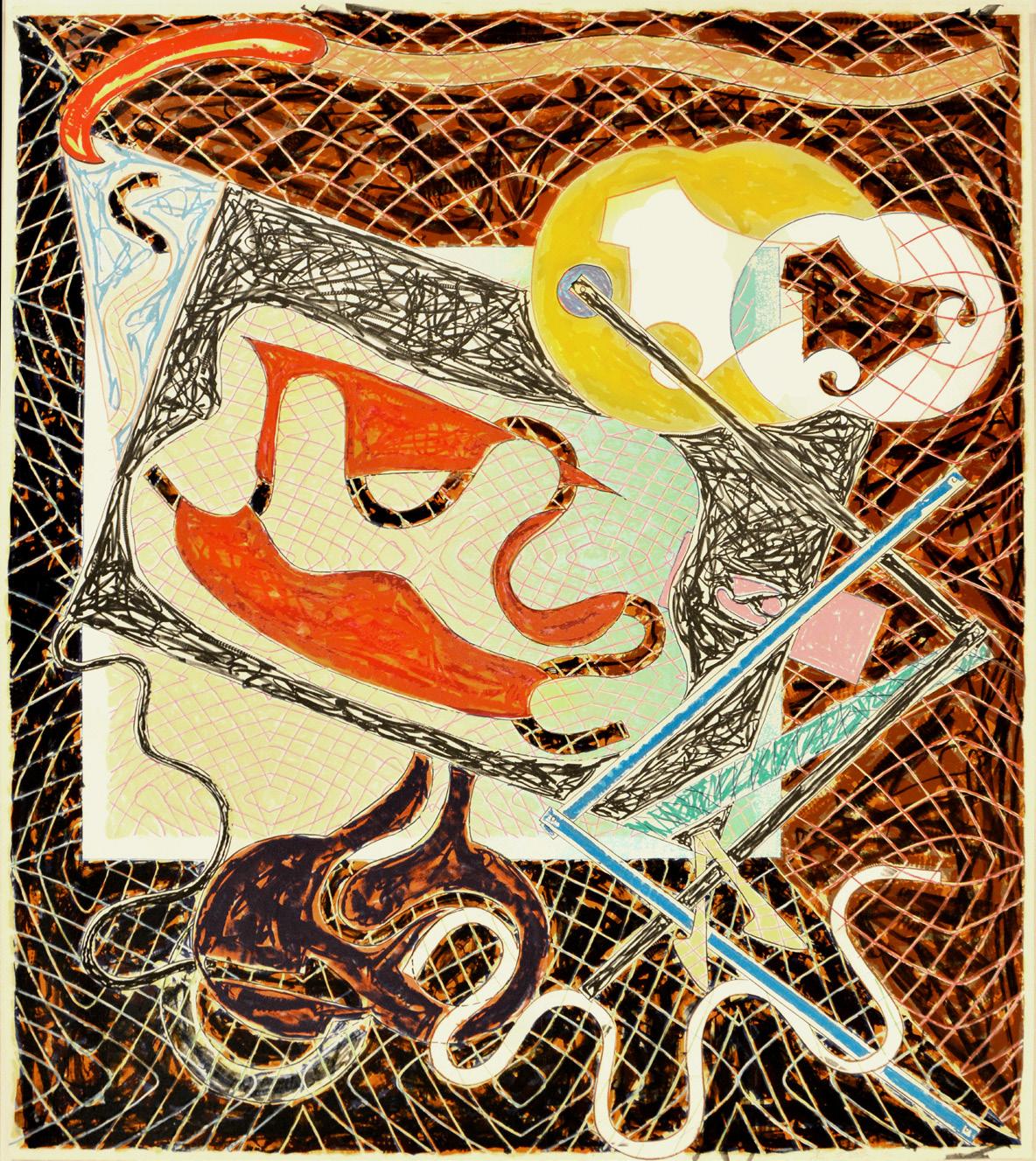 65. STELLA, Frank. Shards III
65. STELLA, Frank. Shards III
66. STELLA, Frank. Libertinia, from Imaginary Places 1995
Over a period of four years, Stella created a body of prints whose titles all came from The Dictionary of Imanginary Places by Alberto Mangual and Gianni Guadalupi. As he had done since the Swan Engravings, Stella employed his full palette of printmaking media, to realise these compositions - including lithography, relief printing, etching, aquatint, engraving and screenprinting.

Relief, screenprint, etching, aquatint, lithograph and engraving in colours, 1995, on TGL handmade paper, signed, dated and numbered form the edition of 50 in pencil (there were also 14 artist’s proofs), published by Tyler Graphics, Ltd., Mount Kisco, New York, with their blindstamp, 54.9 x 125 cm. (21½ x 49¼ in.) Axsom 229
[ref: 105180]


Screenprint, lithograph and linoleum with hand-colouring, marbling and collage, 1989, on T. H. Saunders and Somerset papers, signed in pencil, dated, numbered from the edition of 60 (there were also ten artist’s proofs), printed by Trestle Editions and Brand X, New York, published by Waddington Graphics, London, 172 x 137 cm. (67¾ x 54 in.) Axsom 232 [ref: 106518]
 67. STELLA, Frank. Riallaro, from Imaginary Places 1995
67. STELLA, Frank. Riallaro, from Imaginary Places 1995
item 68



item 69
item 70
item 71

Etching, aquatint, drypoint and collage in colours, 2008, on handmade paper, signed in pencil, numbered from the edition of eight, 122.7 x 92.5 cm. (48¼ x 36½ in.)
[ref: 105482]
Etching, aquatint, drypoint and collage in colours, 2008, on handmade paper, signed in pencil, numbered from the edition of eight, 122.7 x 92.5 cm. (48¼ x 36½ in.)
[ref: 105483]
Etching, aquatint, drypoint and collage in colours, 2008, on handmade paper, signed in pencil, numbered from the edition of eight, 122.7 x 92.5 cm. (48¼ x 36½ in.)
[ref: 105484]
Etching, aquatint, drypoint and collage in colours, 2008, on handmade paper, signed in pencil, numbered from the edition of eight, 122.7 x 92.5 cm. (48¼ x 36½ in.)
[ref: 106978]
 68. VALDES, Manolo. Profil (Joan Miró)
69. VALDES, Manolo. Profil (Frank Stella)
70. VALDES, Manolo. Profil (Andy Warhol)
71. VALDES, Manolo. Profil (Marc Chagall)
68. VALDES, Manolo. Profil (Joan Miró)
69. VALDES, Manolo. Profil (Frank Stella)
70. VALDES, Manolo. Profil (Andy Warhol)
71. VALDES, Manolo. Profil (Marc Chagall)
‘Wild Raspberries’, circa 1959, is a portfolio of uniquely hand-coloured offset lithographs displaying Warhol’s signature blotted line technique. Alongside ‘A Gold Book’, 1957, it is considered one of the most elaborate of Warhol’s self-published works from this period. The series contains illustrations of fanciful foods by Warhol, alongside irreverent and deliberately absurd recipes concocted by Susie Frankfurt. As he did in ‘25 cats name[d] Sam, and One Blue Pussy’, Warhol invited his mother, Julia Warhola, to write the recipes in her calligraphic script.
Offset lithographs with hand-colouring, 1959, on wove paper as issued, each from the edition of unknown size, with the inkstamps of The Estate of Andy Warhol and Andy Warhol Foundation for the visual Arts on the reverse. These were part of an unbound set of works kept by The Warhol Estate and come directly from the Estate.
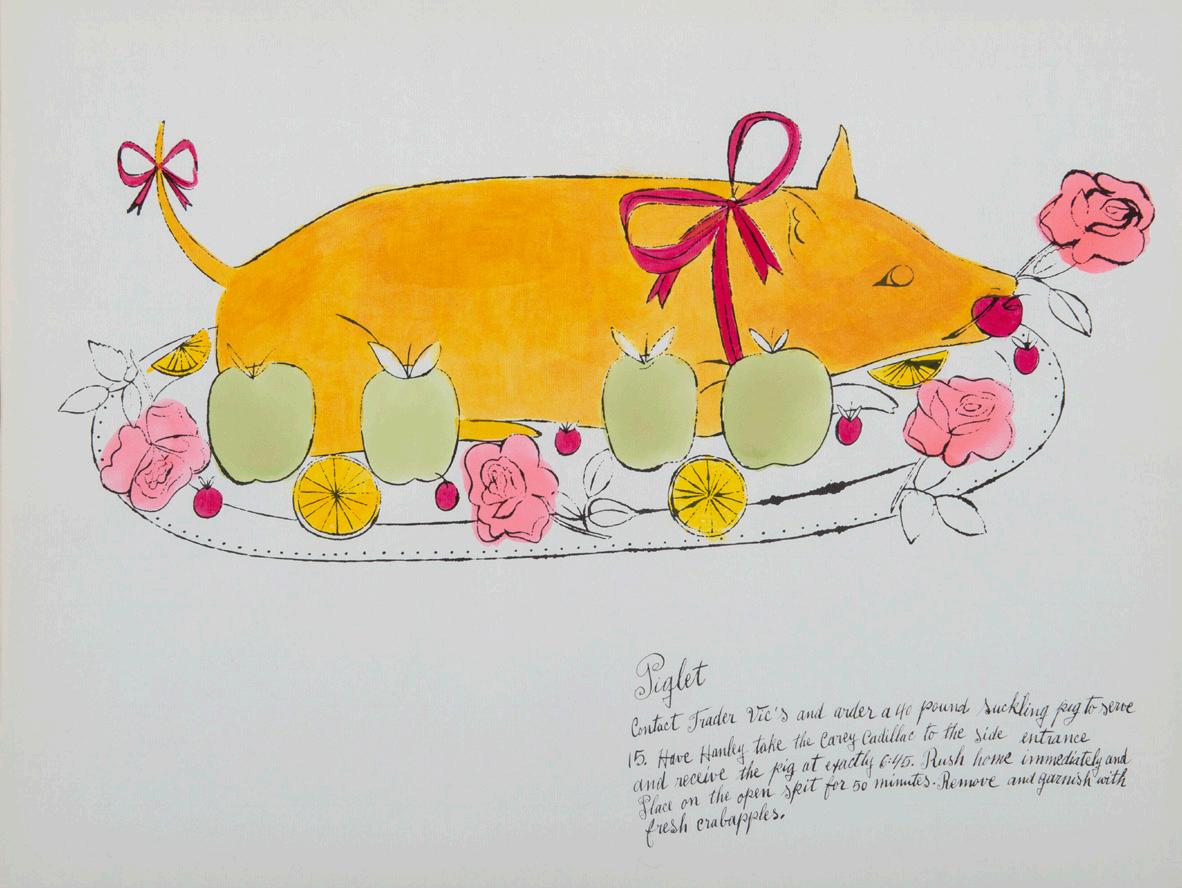
44.4 x 56.9 cm. (17½ x 22½ in.) Feldman & Schellmann IV.134A
[ref: 107998]
72. WARHOL, Andy. Piglet
44.3 x 57 cm. (17½ x 22½ in.)
Feldman & Schellmann IV. 126A/142A
[ref: 108000]
44.3 x 28.4 cm. (17 x 11¼ in.)
Feldman & Schellmann IV.131A
[ref: 107999]
44.3 x 57 cm. (17½ x 22½ in.)
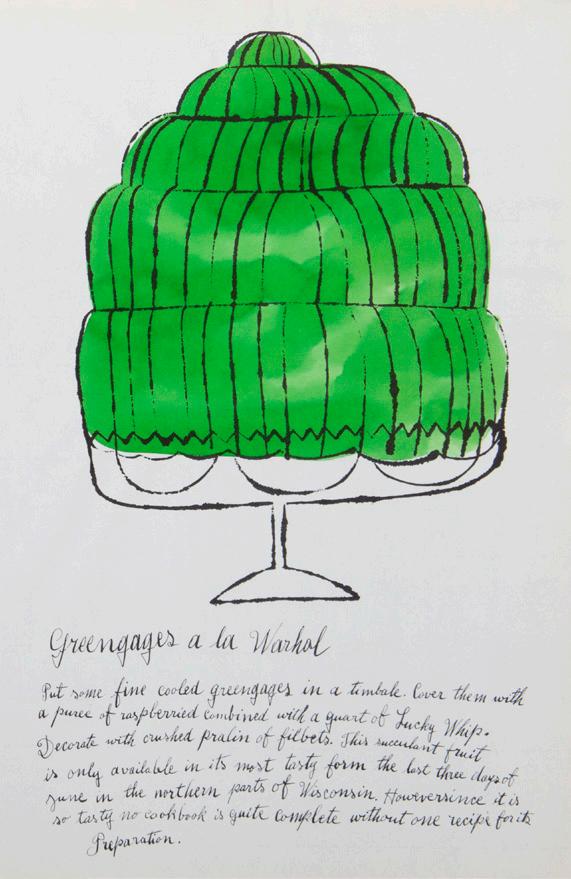
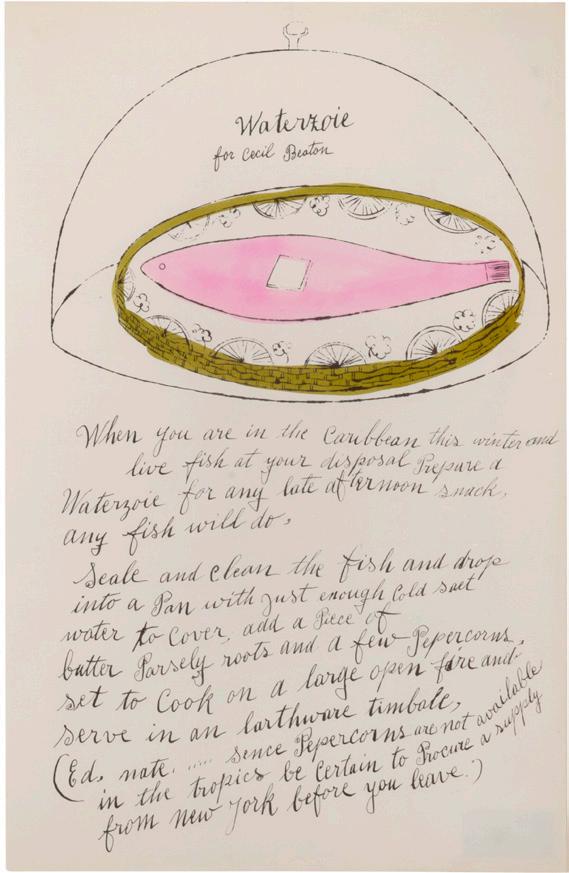
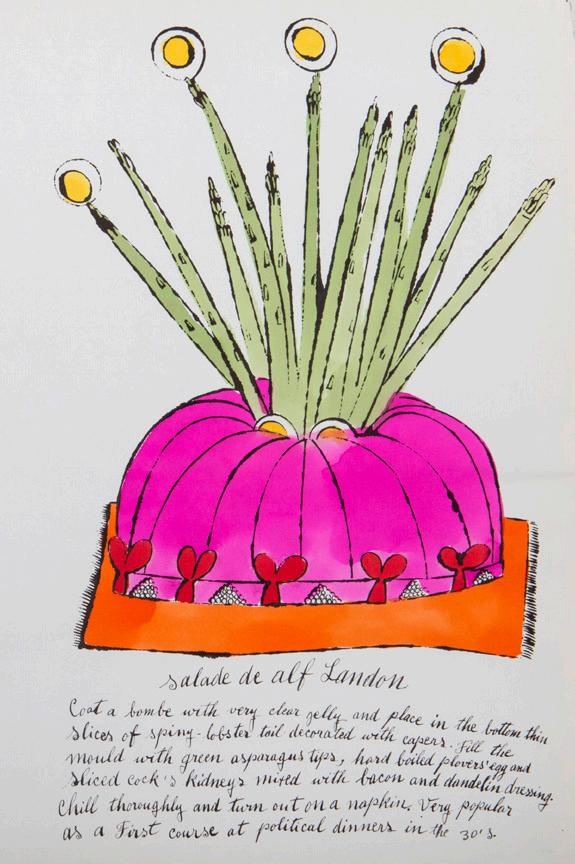
Feldman & Schellmann IV. 143B
[ref: 108001]
73. WARHOL, Andy. Salade de Alf Landon
74. WARHOL, Andy. Waterzoie
75. WARHOL, Andy. Greengages
76 WARHOL, Andy. Beef Consommé, from Campbell’s Soup I
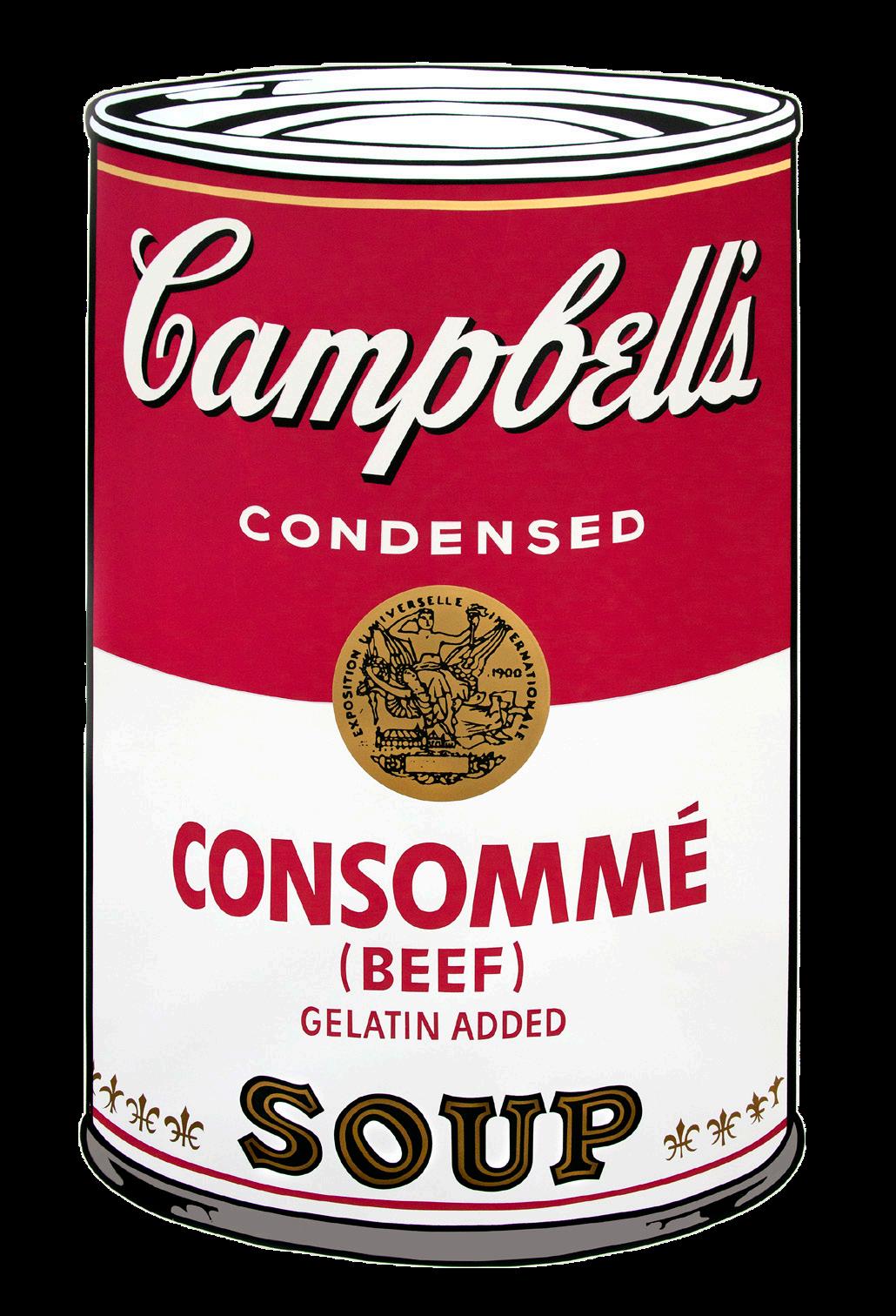
Screenprint in colours, 1968, on wove paper, signed in ball-point pen and numbered with a rubber stamp, verso, from the edition of 250 (there were also 26 artist’s proofs lettered A-Z), printed by Salvatore Silkscreen Co., Inc., New York, published by Factory Additions, New York, 88.9 x 58.4 cm. (35 x 23 in.) Feldman & Schellmann II.52
[ref: 105707]
Screenprint in colours, 1969, on wove paper, signed in ball-point pen and numbered with a rubber stamp, verso, from the edition of 250 (there were also 26 artist’s proofs lettered A-Z), printed by Salvatore Silkscreen Co., Inc., New York, published by Factory Additions, New York, 88.9 x 58.4 cm. (35 x 23 in.) Feldman & Schellmann II.58
[ref: 105257]


Screenprint in colours, 1969, on wove paper, signed in ball-point pen and numbered with a rubber stamp verso, from the edition of 250 (there were also 26 artist’s proofs lettered A-Z), printed by Salvatore Silkscreen Co., Inc., New York, published by Factory Additions, New York, 88.9 x 58.4 cm. (35 x 23 in.) Feldman & Schellmann II.63
[ref: 107059]
77. WARHOL, Andy. Chicken ‘N Dumplings, from Campbell’s Soup II
78. WARHOL, Andy. Cheddar Cheese, from Campbell’s Soup II
The ‘Flowers (Hand-Colored)’ series closely followed the earlier series ‘Flowers (Black and White)’ with one significant difference, the exquisite hand-colouring Warhol applied to these screenprints making each unique. Made in 1974, this series is a sudden diversion away from his typical artistic style of the time since the artist’s hand is very much felt with the addition of this hand-colouring – Warhol usually delighted in removing all trace of his presence from his work.
Through this series we are reminded of what a talented draftsman Warhol was whilst first working as a commercial artist in the 1950s. The freehand lines Warhol uses to capture these still-life flowers and the bursts of vibrant colour are also reminiscent of his earlier offset lithographs from the 1950s like ‘A La Recherche Du Shoe Perdu’ and ‘Wild Raspberries’.
Unique screenprints in black & white, hand-coloured with Dr. Martin’s aniline watercolor dyes, 1974, on Arches and J. Green paper, each initialled in pencil by the artist, also signed by the artist in pencil, dated ‘74 and numbered on the reverse, from the edition of 250 (there were also 50 artist’s proofs), printed by Alexander Heinrici, New York, co-published by Peter M. Brant, Castelli Graphics, and Mutiples, Inc., New York, with their inkstamp on the reverse.
79. WARHOL, Andy. Flowers (Hand-Colored) (F & S II.114)
102.9 x 69 cm. (40½ x 27¼ in.) Feldman & Schellmann II.114
[ref: 107977]
80. WARHOL, Andy. Flowers (Hand-Colored) (F & S II.115) 103 x 69.7 cm. (40½ x 27½ in.) Feldman & Schellmann II.115
[ref: 107978]
81. WARHOL, Andy. Flowers (Hand-Colored) (F & S II.110) 104 x 69.5 cm. (41 x 27¼ in.) Feldman & Schellmann II.110
[ref: 107981]
82. WARHOL, Andy. Flowers (Hand-Colored) (F & S II.110) 104 x 69.5 cm. (41 x 27¼ in.) Feldman & Schellmann II.110
[ref: 108195]
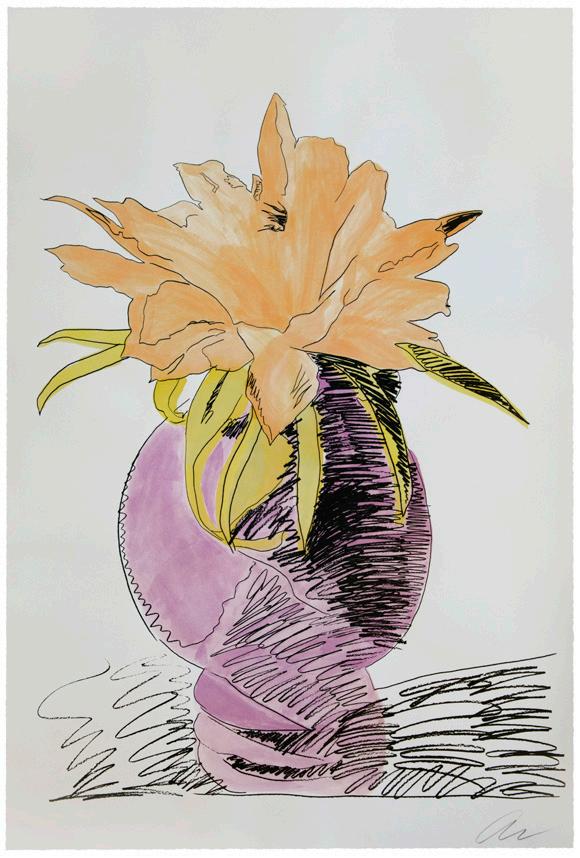
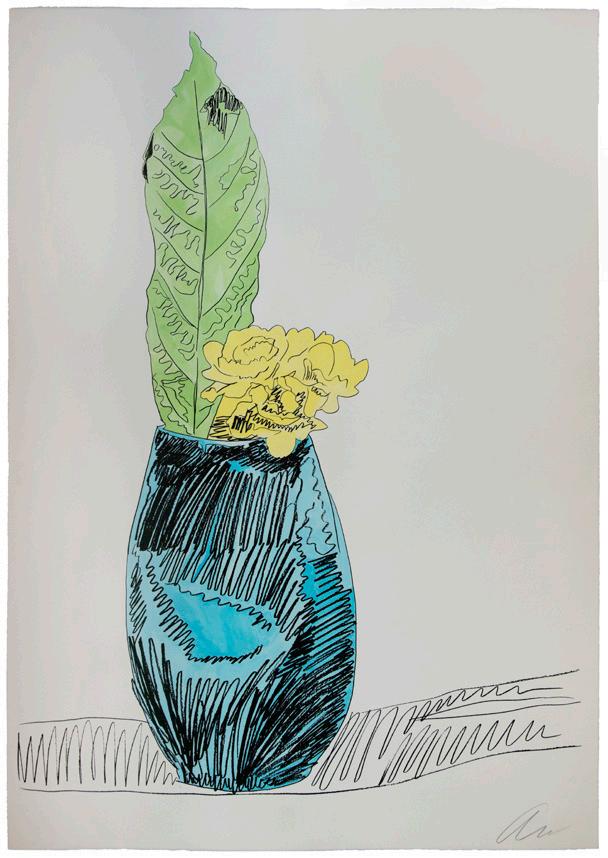
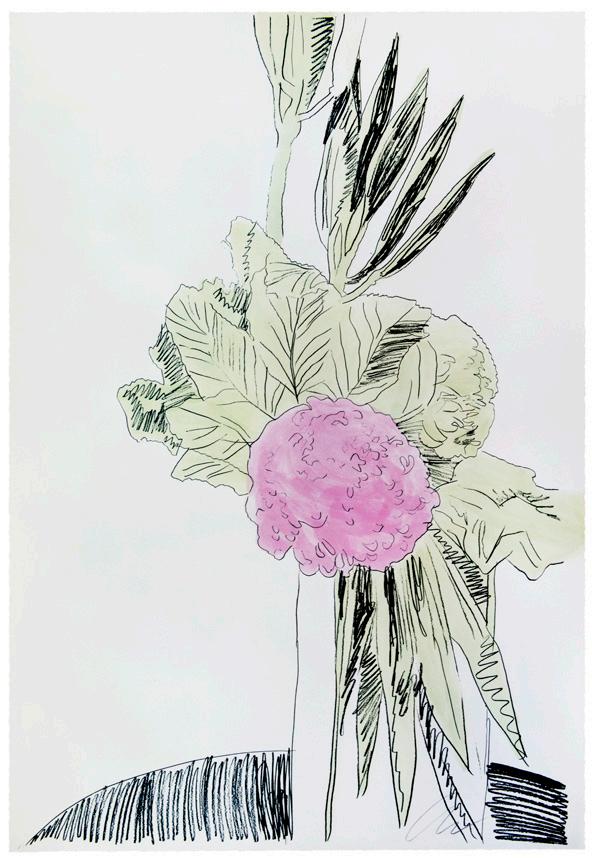

item 79
80 item 81
82
item
item
104 x 69.5 cm. (41 x 27¼ in.)
Feldman & Schellmann II.118
[ref: 108196]
103 x 69.6 cm. (40½ x 27½ in.)
Feldman & Schellmann II.116
[ref: 107979]
The ‘Ladies and Gentlemen’ series was the result of a commission by Italian art dealer Luciano Anselmino to produce ‘impersonal and anonymous’ portraits of Trans women and Drag Queens in New York City. Warhol took over five hundred Polaroids of fourteen models, enlarging a selection of these onto silkscreens. Bold washes of colour are brushed over the sitters, whose poses explore gender ambiguity. The result deviates from the original proposal, celebrating the personality and glamour of the models.
Screenprint in colours, 1975, on textured watercolour Arches paper, signed by the artist in pencil on the reverse, numbered from the edition of 250 (there were also 50 artist’s proofs in roman numerals), published by Mazzota Editore, Milan, 95.2 x 64.8 cm. (37½ x 25½ in.) Feldman & Schellmann II.127
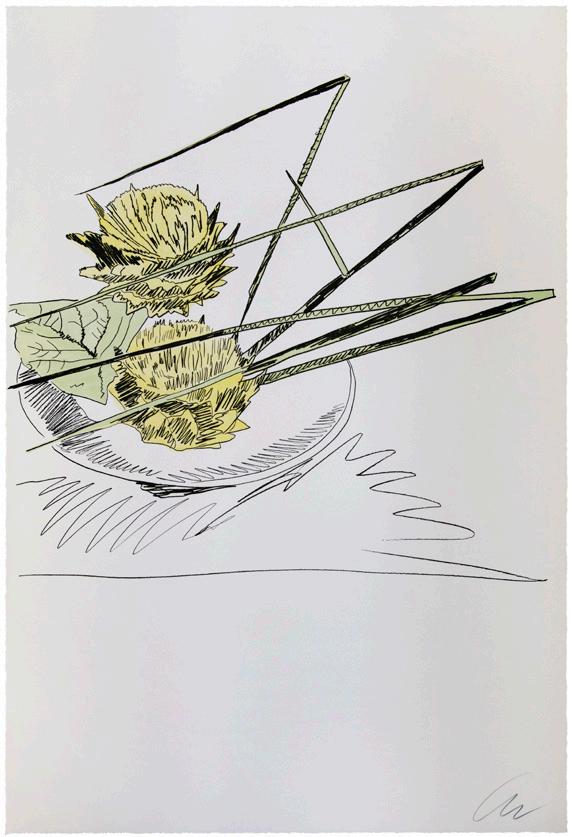
[ref: 103124]
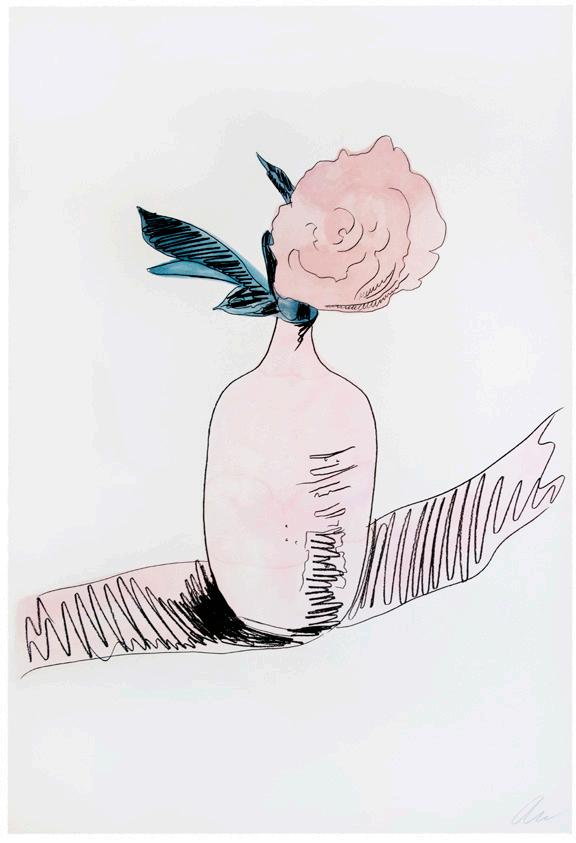 83. WARHOL, Andy. Flowers (Hand-Colored) (F & S II.118)
85. WARHOL, Andy. Ladies and Gentlemen
84. WARHOL, Andy. Flowers (Hand-Colored) (F & S II.116)
83. WARHOL, Andy. Flowers (Hand-Colored) (F & S II.118)
85. WARHOL, Andy. Ladies and Gentlemen
84. WARHOL, Andy. Flowers (Hand-Colored) (F & S II.116)

86. WARHOL, Andy. Peaches, from Space Fruits: Still Lifes

Screenprint in colours, 1979, on Lennox Museum board, signed and numbered from the edition of 150, printed by Rupert Jasen Smith and Joe Grippi, New York, published by Grippi/Zivian, Inc., New York, 76.2 x 101.6 cm. (30 x 40 in.) Feldman & Schellmann II.202
[ref: 107024]
87. WARHOL, Andy. Pears, from Space Fruits: Still Lifes 1979

Screenprint in colours, 1979, on Lennox Museum board, signed and numbered from the edition of 150, published by Grippi/Zivian, Inc., New York, printed by Rupert Jasen Smith and Joe Grippi, New York, 76.2 x 101.6 cm. (30 x 40 in.) Feldman & Schellmann II.203
[ref: 107025]

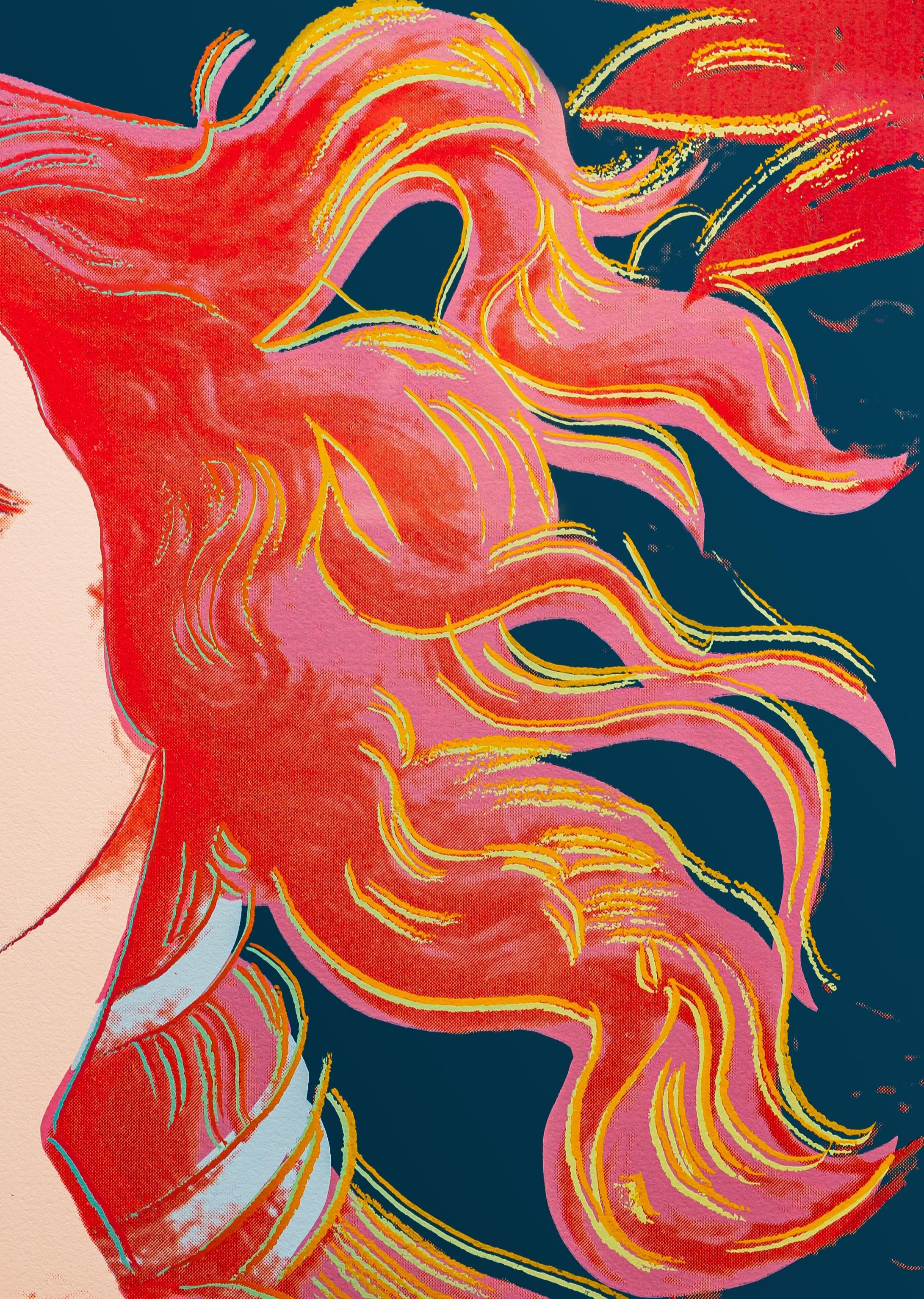
88. WARHOL, Andy. Details of Renaissance Paintings: Sandro Botticelli, Birth of Venus, 1482
In 1984, Warhol’s work took a new direction when he initiated the Details of Renaissance Paintings series, moving away from portraits of celebrities. In this print, Warhol puts his own spin on the iconic image of the Birth of Venus, as depicted by Sandro Botticelli in the 15th century. Placing the Roman goddess firmly in the present, the result is a poignant statement on the mass consumption of artistic masterworks.
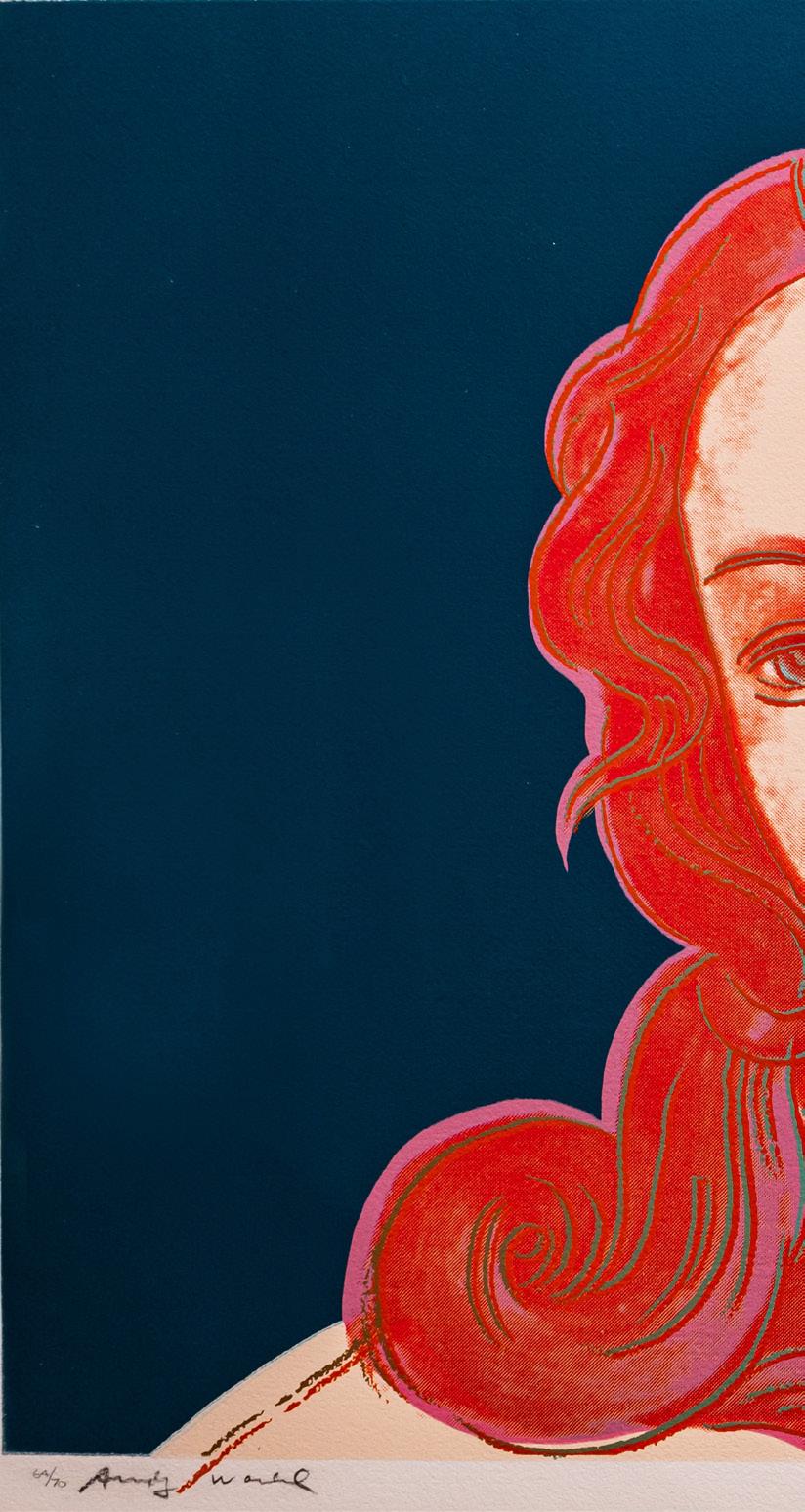
Screenprint in colours, 1984, on Arches Aquarelle paper, signed and numbered from the edition of 70, printed by Rupert Jasen Smith, New York, published by Editions Schellmann & Kluser, Munich/New York, 82 x 111.5 cm. (32¼ x 44 in.) Feldman & Schellmann II.316
[ref: 108024]

89. WARHOL, Andy. Northwest Coast Mask, from Cowboys & Indians
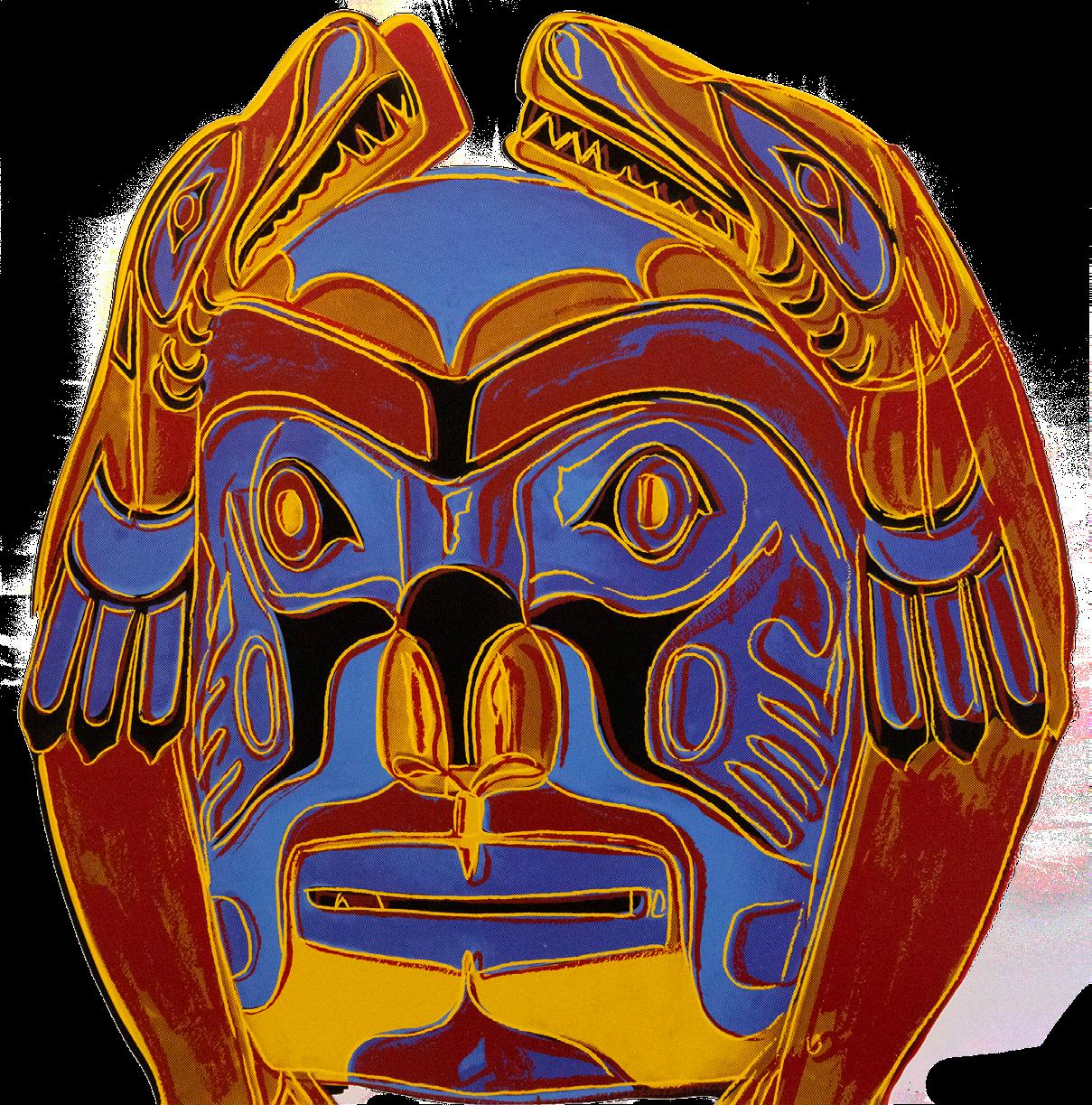
Belonging to Andy Warhol’s 1986 ‘Cowboys and Indians’ portfolio, the present work explores the American West and its portrayal in Hollywood. In this work, Warhol represents a stylised version of a mask worn for cultural celebrations in indigenous communities. Often representing local spirits and used in rituals intended to connect the wearer to the spiritual world, Warhol’s mask evokes the American romanticisation of the Old West as an arena in which heroic narratives are played out, raising larger questions about the media’s distortion of reality.
Screenprint in colours, 1986, on Lenox Museum Board, signed in pencil, numbered from the edition of 250 (there were also 50 artist’s proofs), printed by Rupert Jason Smith, New York, published by Gaultney, Klineman Art, Inc., New York, with their ink stamp and the artist’s copyright ink stamp, verso, 91.4 x 91.4 cm. (36 x 36 in.) Feldman & Schellmann II.380
[ref: 105585]
 1. ABNEY, Nina Chanel. Temporary Friends
1. ABNEY, Nina Chanel. Temporary Friends




 2. CALDER, Alexander. L’Acier du Constructeur 1965
2. CALDER, Alexander. L’Acier du Constructeur 1965
 3. CALDER, Alexander. Encore de l’Acier 1969
3. CALDER, Alexander. Encore de l’Acier 1969















 8. FRANCIS, Sam. Untitled (SFE-081)
9. FRANCIS, Sam. Untitled (SFE-085)
8. FRANCIS, Sam. Untitled (SFE-081)
9. FRANCIS, Sam. Untitled (SFE-085)
 10. FRANKENTHALER, Helen. Orient Express #6
10. FRANKENTHALER, Helen. Orient Express #6

 11. FRANKENTHALER, Helen. Tribal Sign 1987
11. FRANKENTHALER, Helen. Tribal Sign 1987
 12. FRANKENTHALER, Helen. Ramblas 1987
12. FRANKENTHALER, Helen. Ramblas 1987
 13. FRANKENTHALER, Helen (after). Mary, Mary 1990
13. FRANKENTHALER, Helen (after). Mary, Mary 1990

 15. FRANKENTHALER, Helen. Flotilla 2006
15. FRANKENTHALER, Helen. Flotilla 2006
 16. GUSTON, Philip. Pile Up
16. GUSTON, Philip. Pile Up













 19. JOHNS, Jasper. The Critic Sees, from Ten from Leo Castelli portfolio 1967
19. JOHNS, Jasper. The Critic Sees, from Ten from Leo Castelli portfolio 1967





 24. LICHTENSTEIN, Roy. Entablature III, from Entablature Series
24. LICHTENSTEIN, Roy. Entablature III, from Entablature Series

 25. LICHTENSTEIN, Roy. Flowers 25 Neujahrsgaben der Galerie Beyeler
25. LICHTENSTEIN, Roy. Flowers 25 Neujahrsgaben der Galerie Beyeler

 27. MIRO, Joan. Plate III, from Album 19 1961
28. MIRO, Joan. Plate IV, from Album 19 1961
27. MIRO, Joan. Plate III, from Album 19 1961
28. MIRO, Joan. Plate IV, from Album 19 1961

 29. MIRO, Joan. Plate VI, from Album 19 1961
30. MIRO, Joan. Plate X, from Album 19 1961
29. MIRO, Joan. Plate VI, from Album 19 1961
30. MIRO, Joan. Plate X, from Album 19 1961

 31. MIRO, Joan. Plate XII, from Album 19 1961
32. MIRO, Joan. Plate XIV, from Album 19 1961
31. MIRO, Joan. Plate XII, from Album 19 1961
32. MIRO, Joan. Plate XIV, from Album 19 1961

 33. MIRO, Joan. Plate XVI, from Album 19 1961
34. MIRO, Joan. Plate XIX, from Album 19 1961
33. MIRO, Joan. Plate XVI, from Album 19 1961
34. MIRO, Joan. Plate XIX, from Album 19 1961











 43. PICASSO, Pablo. Bouquet dans un Vase
43. PICASSO, Pablo. Bouquet dans un Vase

 45. PICASSO, Pablo. Fumeur à la Cigarette Rouge (B., BA. 1167)
45. PICASSO, Pablo. Fumeur à la Cigarette Rouge (B., BA. 1167)



 PICASSO, Pablo. Trois nus
PICASSO, Pablo. Trois nus

 47. PICASSO, Pablo. Plate 2, from Le Cocu Magnifique [ref: 106682]
47. PICASSO, Pablo. Plate 2, from Le Cocu Magnifique [ref: 106682]

 48. PICASSO, Pablo. Plate 4, from: Le Cocu Magnifique [ref: 106681]
49. PICASSO, Pablo. Plate 10, from: Le Cocu Magnifique [ref: 106679]
48. PICASSO, Pablo. Plate 4, from: Le Cocu Magnifique [ref: 106681]
49. PICASSO, Pablo. Plate 10, from: Le Cocu Magnifique [ref: 106679]

 50. PICASSO, Pablo. Plate 11, from: Le Cocu Magnifique [ref: 106680]
51. PICASSO, Pablo. Plate 12, from: Le Cocu Magnifique [ref: 106678]
50. PICASSO, Pablo. Plate 11, from: Le Cocu Magnifique [ref: 106680]
51. PICASSO, Pablo. Plate 12, from: Le Cocu Magnifique [ref: 106678]














 63. STELLA, Frank. Lunna Wola (V), from Paper Reliefs
63. STELLA, Frank. Lunna Wola (V), from Paper Reliefs

 65. STELLA, Frank. Shards III
65. STELLA, Frank. Shards III



 67. STELLA, Frank. Riallaro, from Imaginary Places 1995
67. STELLA, Frank. Riallaro, from Imaginary Places 1995




 68. VALDES, Manolo. Profil (Joan Miró)
69. VALDES, Manolo. Profil (Frank Stella)
70. VALDES, Manolo. Profil (Andy Warhol)
71. VALDES, Manolo. Profil (Marc Chagall)
68. VALDES, Manolo. Profil (Joan Miró)
69. VALDES, Manolo. Profil (Frank Stella)
70. VALDES, Manolo. Profil (Andy Warhol)
71. VALDES, Manolo. Profil (Marc Chagall)












 83. WARHOL, Andy. Flowers (Hand-Colored) (F & S II.118)
85. WARHOL, Andy. Ladies and Gentlemen
84. WARHOL, Andy. Flowers (Hand-Colored) (F & S II.116)
83. WARHOL, Andy. Flowers (Hand-Colored) (F & S II.118)
85. WARHOL, Andy. Ladies and Gentlemen
84. WARHOL, Andy. Flowers (Hand-Colored) (F & S II.116)








